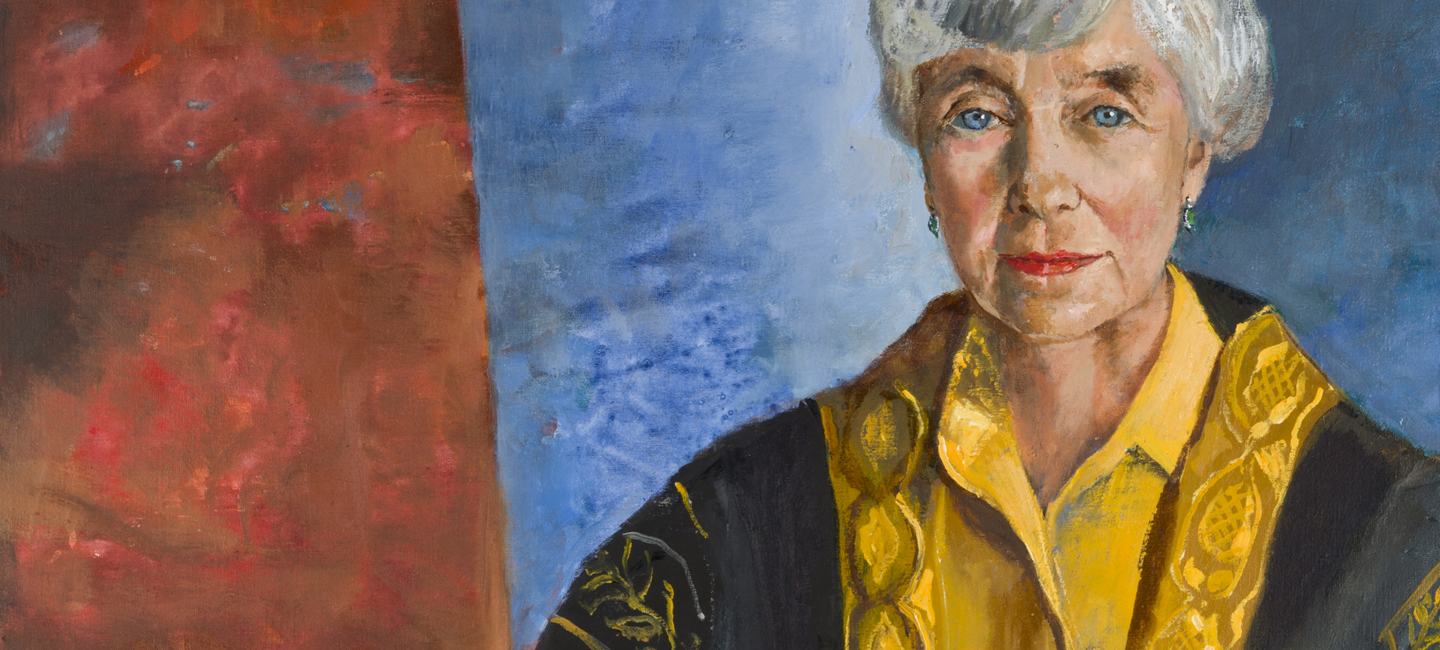

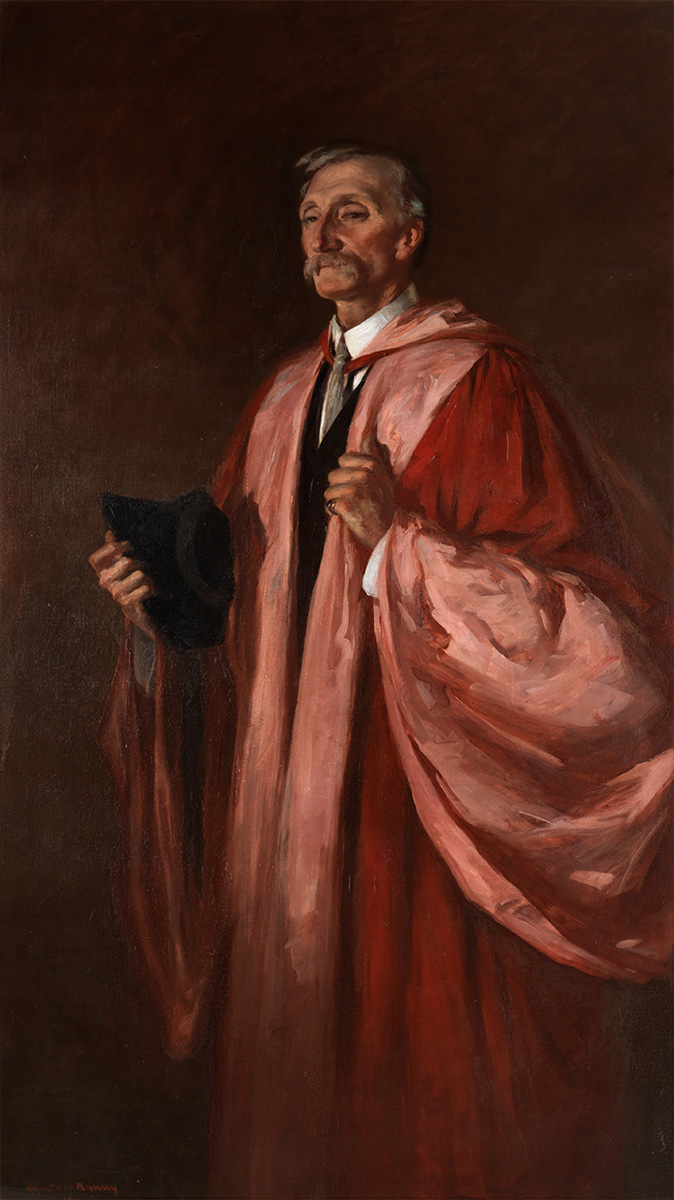 © Trinity College, the University of Melbourne
© Trinity College, the University of Melbourne
Dr Alexander Leeper
1911 Rupert Bunny 1864 - 1947 192.5 x 121.5 [framed] AC 000010Inaugural Warden of Trinity College, 1876-1918
Alexander Leeper was appointed Principal of Trinity College on 6 January, 1876. His term of office would last forty-two years, during which time the shape of the College, the University, and Melbourne itself changed significantly. The College was a mere six years old when Leeper arrived to take up the reins and the man himself barely in sight of his twenty-eighth birthday. Leeper's education was well-rounded, his academic accomplishments prodigious. Born in Dublin in 1848, the second son of the Revd Alexander Leeper, he completed a Bachelor's degree at Trinity College, Dublin in 1871 where he was awarded the Berkeley Gold Medal. In 1875 Leeper was awarded First Class Honours in Classical Moderations at St John's College, Oxford. His grounding as a Classics scholar was to have an indelible effect on the complexion of Trinity College as a place of academic endeavour and as an exemplar in the development of the collegiate system throughout Australia.
A widely travelled man, Leeper had visited Australia in 1869 where he met Sir George Wigram Allen's daughter, Adeline Marian, whom he would later marry, in the summer of 1879. When he took up his post as Principal of Trinity College, he had charge of only five students. By 1912 when Bunny's portrait of him was unveiled, the College could boast fifty-seven resident students. According to Dutton Green, Vice-President of the Union of the Fleur-de-Lys, the College's alumni association, Leeper had "converted what had been described as a Church of England boarding house to a real live college".
Moves to commission a portrait of Leeper began in 1910, when, at the annual dinner of the Union of the Fleur-de-Lys, members unanimously decided that a portrait of the Warden was long overdue. It was to be purchased through subscriptions limited to one guinea, the intention being to "make the presentation a representative one." It proved to be a timely resolution, for the Union was able to secure the artist Rupert Bunny to undertake the commission. Bunny had returned to Australia on 29 May, 1911, after having lived abroad for twenty-seven years.
On the evening of Thursday 2 May, 1912, Bunny's portrait of Alexander Leeper, first Warden of Trinity College, was presented to the College by the Union of the Fleur-de-Lys. According to the Union's magazine of June 1912, "The presentation was made in the Dining Hall, in the presence of a large muster of past and present students and friends of the College and other members of the University, by Mr. Dutton Green, the senior Vice-President of the Union". In his presentation speech Mr Green was reported to have said that "the history of Trinity College was practically the history of Dr Leeper's distinguished career among them."
Presented to the College by the Union of the Fleur-de-Lys, 1912
Trinity College Art Collection
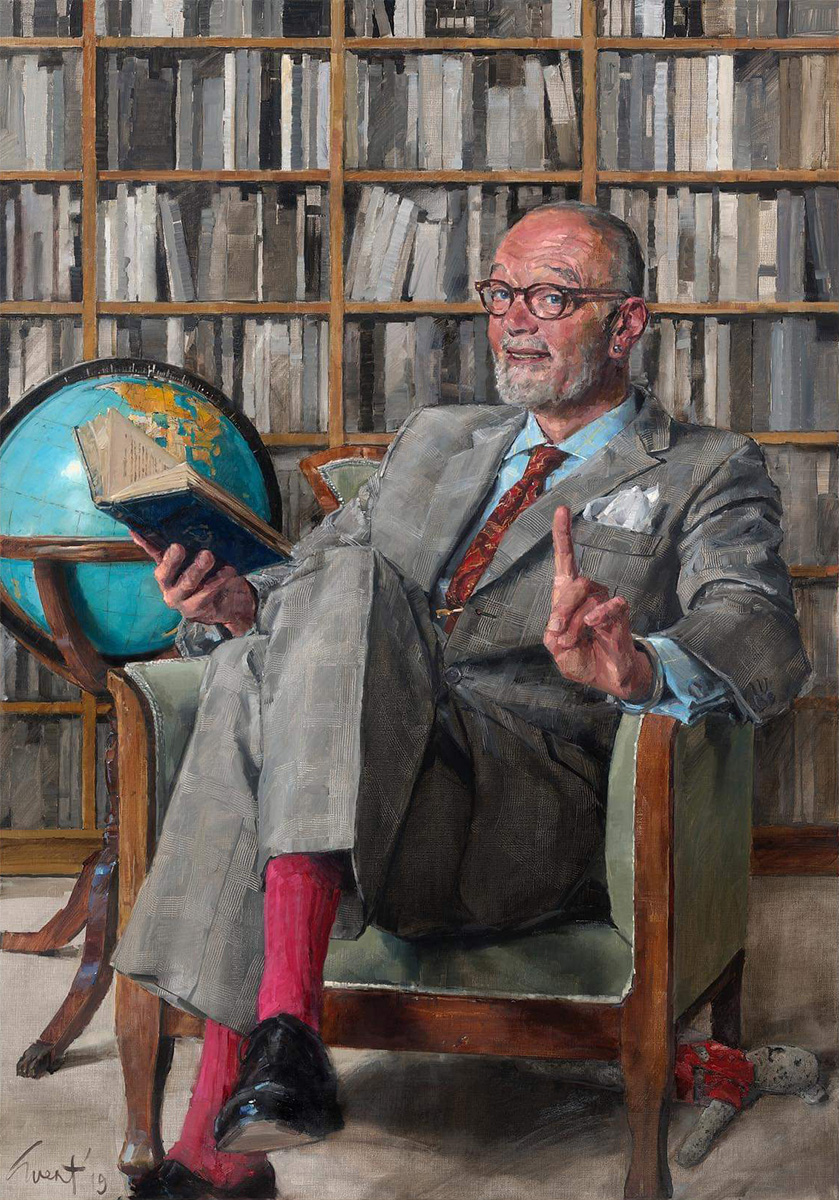 © the artist and Trinity College, the University of Melbourne
© the artist and Trinity College, the University of Melbourne
Angus Trumble (TC 1983)
2019 Evert Ploeg 1963 - oil on linen 137.0 x 97.0 cm [framed] AC 000793Scholar, curator and Director of the National Portrait Gallery, Australia (2014-2018)
‘Angus Trumble was one of the most memorable writers on art that Australia has known’, Prof Jaynie Anderson wrote last November. Trumble’s unexpected death, aged 58, only months after being installed as a Fellow of the college, has left a irreplaceable hole in international art circles.
Art curator and distinguished historian, a witty writer and museum director, Trumble was director of the National Portrait Gallery (NPG), Canberra, from 2014-2018. He had been Senior Curator of Paintings and Sculpture at the Yale Centre for British Art since 2003 before returning to Australia to take up the directorship.
As director, he worked closedly with artist Evert Ploeg on a number of commissioned works for the NPG. A fitting combination, the artist turning his brushes on the out-going director. Approached by Trinity to undertake the commission, Ploeg and Trumble had unexpectedly just completed the work on their own initiative.
‘I have always had a great interest in history as distinct from art history,’ Trumble said in 2014, ‘so for me a national portrait gallery is the ideal place to be because it’s where stories about people form essentially a national narrative, historical in the past, present and future as well’.
Trinity College Art Collection
 © the artist's estate and The University of Melbourne
© the artist's estate and The University of Melbourne
Laura Moerlin (Mrs M P Fox)(TC 1884)
1888 Marian Pirani 1861 - 1939 oil on canvas 2006.0002.000.000Supported by a Warden’s Exhibition, Laura Mary Fox (née Moerlin) attended tutorials at Trinity College in 1884. The following year, in the final year of her degree, she was awarded a scholarship in the School of Classics and Philology, ‘thus obtaining the distinction of being the first lady who had succeeded in gaining a scholarship in this University.’
Moerlin was the first Trinity woman to graduate, when she received her Bachelor of Arts in 1885, and the third from The University of Melbourne. Reporting on the annual commencement that year, the Argus newspaper wrote that, ‘the most enthusiastic cheering was reserved for the only lady graduate presented, Miss Laura Moerlin’. She was the University’s second woman to obtain the Master of Arts degree two years later.
Commemorating this achievement, this painting by Marian Pirani is the earliest portrait of a female scholar in The University of Melbourne Art Collection and is still one of only a handful held today. Pirani (née Rennick) studied at the National Gallery School in the early 1880s under George Folingsby, along with fellow students Rupert Bunny, John Longstaff and Frederick McCubbin. Months after completing this work, she married (Sir) James William Barrett, who became vice-chancellor of The University of Melbourne in 1931.
Gift of Mr Philip Fox, 2006
On loan from the University of Melbourne
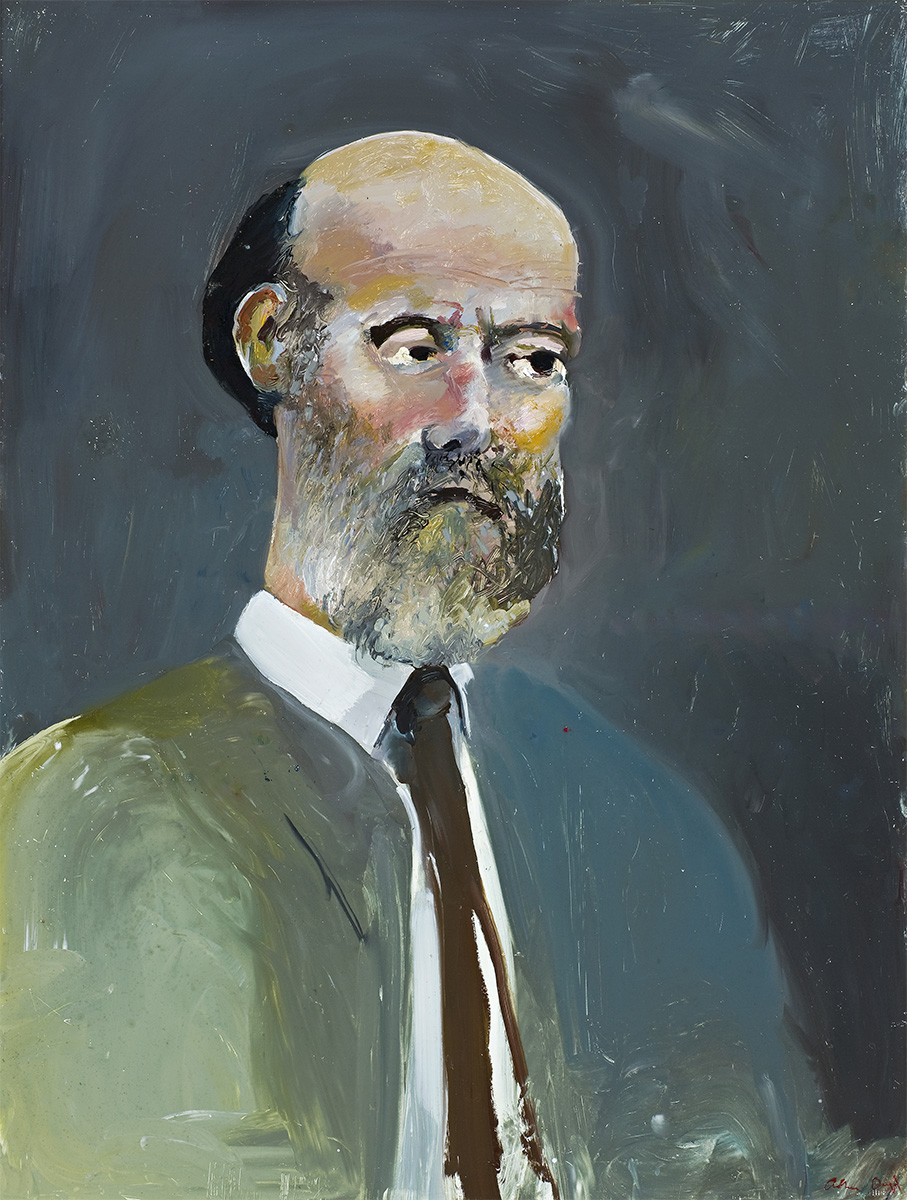 © Bundanon Trust and Trinity College, the University of Melbourne
© Bundanon Trust and Trinity College, the University of Melbourne
Professor Manning Clark (TC 1934)
1972 Arthur Boyd 1920 - 1999 oil on canvas 130.5 x 100.2 [framed] AC 000475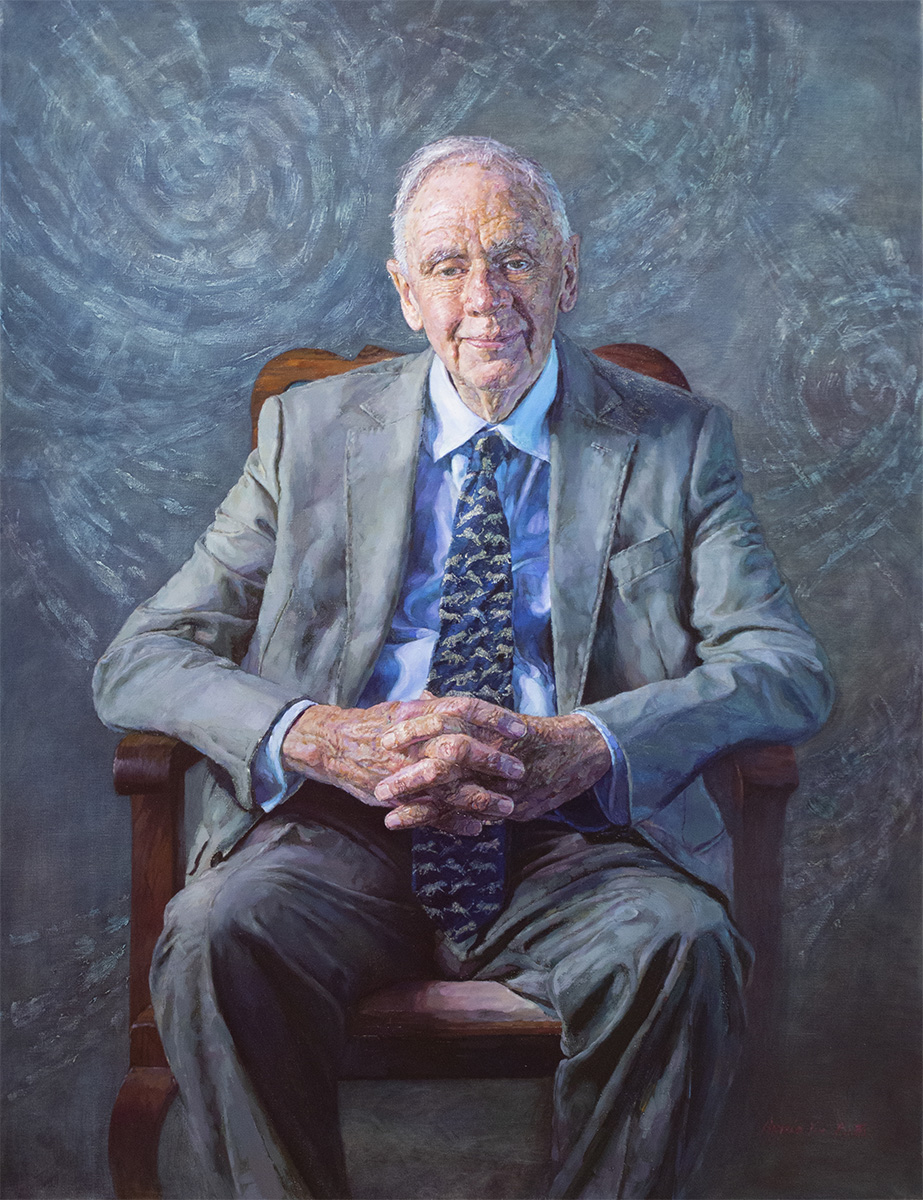 © the artist and Trinity College, the University of Melbourne
© the artist and Trinity College, the University of Melbourne
Denis White
2019 Apple Yin 2019 oil on canvas 120.5 x 90.5 cm AC 000789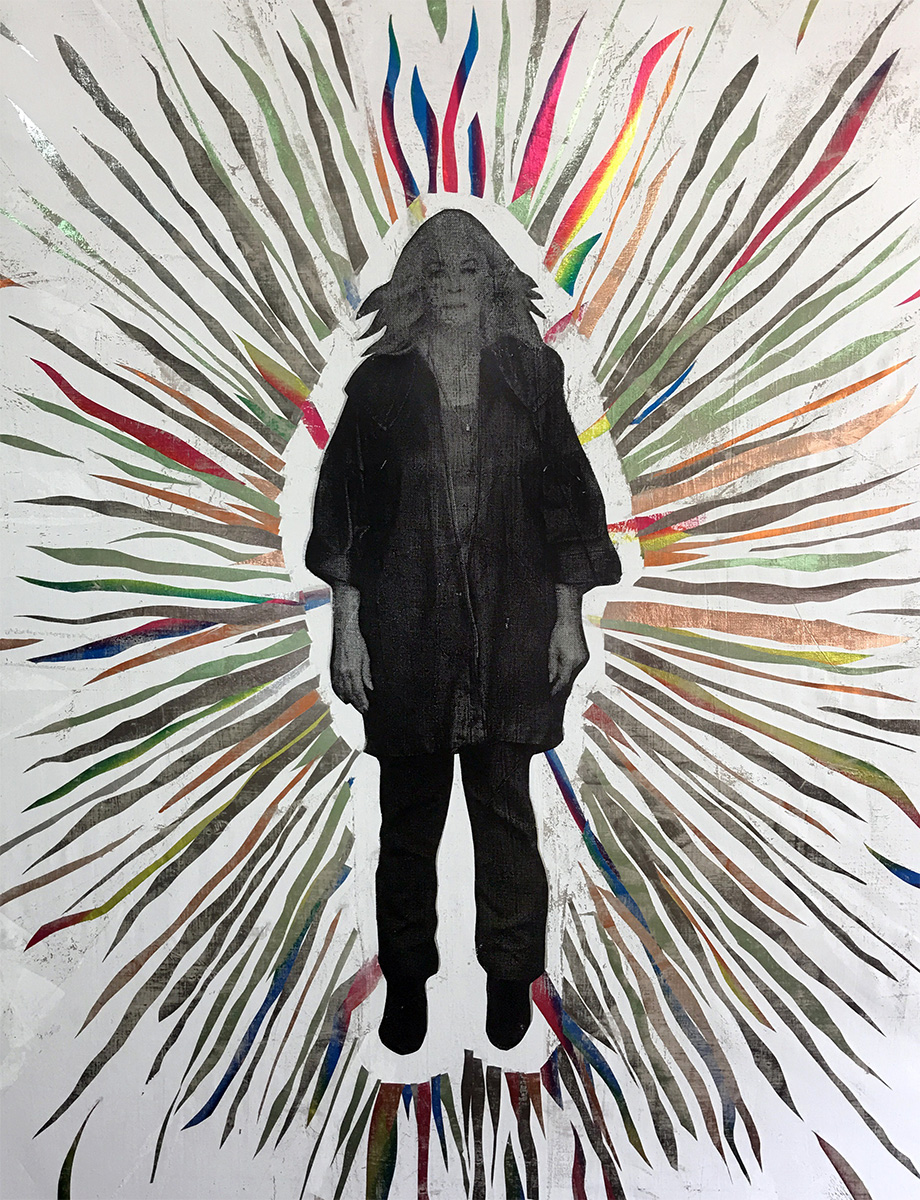 © the artist and Trinity College, the University of Melbourne
© the artist and Trinity College, the University of Melbourne
Professor Marcia Langton
2017 Brook Andrew 1970 - mixed media on canvas 192.0 x 160.0 cm AC 000756Academic, writer and Foundation Chair of Australian Indigenous Studies, University of Melbourne (2000 - )
The front cover of The Monthy magazine in April 2011 was emblazoned with its feature article’s title, ‘Who’s Afraid of Marcia Langton’. Across a long and distinguished academic career, Langton has garned deep respect, and a few detractors, for her fierce activism for Indigenous rights and education.
A Yiman and Bidjara woman, Langton grew up in south-central Queensland, before studying anthropology at the Australian National University, Canberra, where she became the first Indigenous honours graduate in that discipline. Since 2000, Langton has held the Foundation Chair of Australian Indigenous Studies at The University of Melbourne and in 2017 was made an Associate Provost of the university. She was installed as a Fellow of Trinity College in 2012, in recognition of her continuing support and contribution to the college’s Indigenous programs.
This is the second portrait of Langton by Wiradjuri interdisciplinay artist and curator Brook Andrew who, together with printer Trent Walker, produced the 2009 portrait of Langton in a Buddhist pose, now held by the National Portrait Gallery, Canberra. Andrew was Artistic Director of the 22nd Biennale of Sydney in 2020
In 2022, Professor Andrew was appointed as Director of Reimagining Museums and Collections at The University of Melbourne.
Commissioned by the Trinity College Art Committee, 2015
Trinity College Art Collection
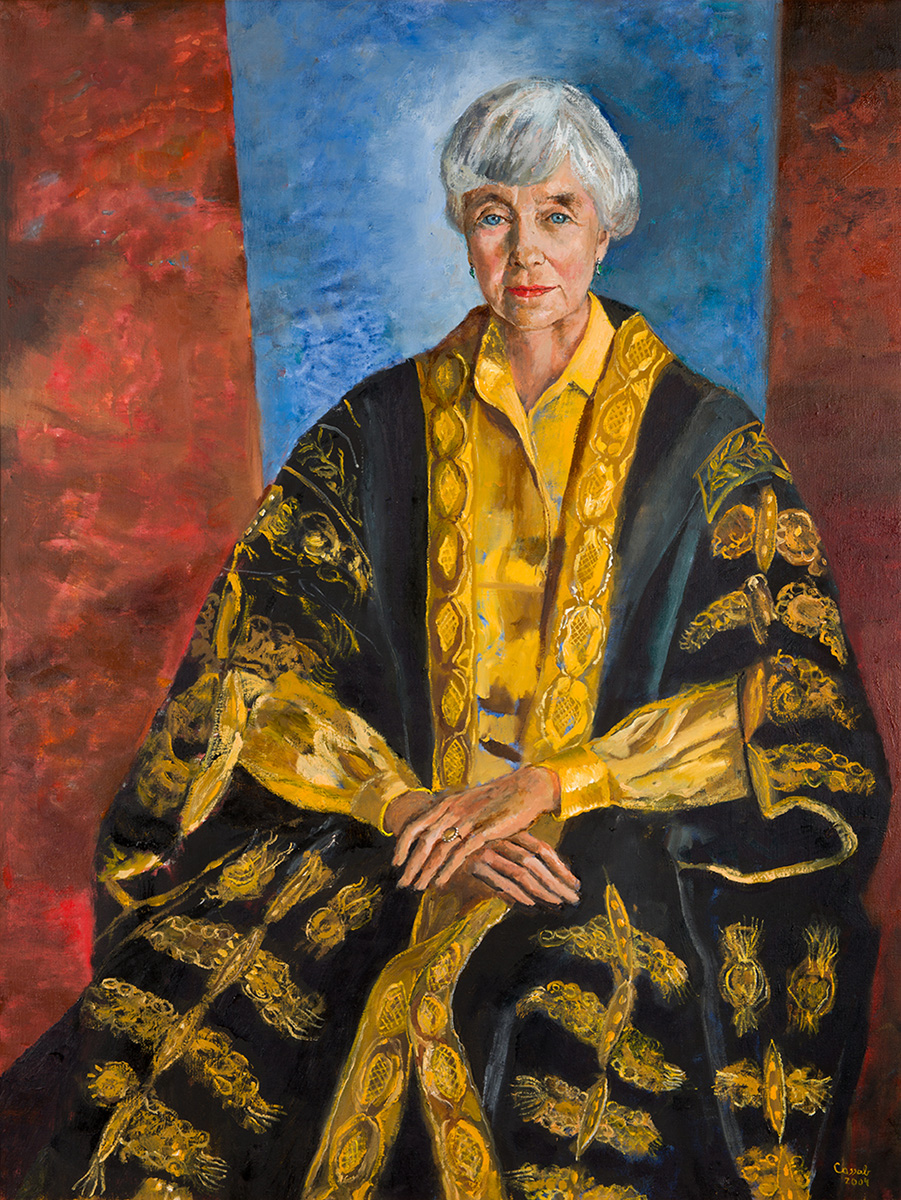 © artist's estate and Trinity College, the University of Melbourne
© artist's estate and Trinity College, the University of Melbourne
Dame Leonie Kramer AC, DBE (JCH 1942)
2005 Judy Cassab 1920 - 2015 oil on canvas 143.0 x 112.3 cm [framed] AC 000180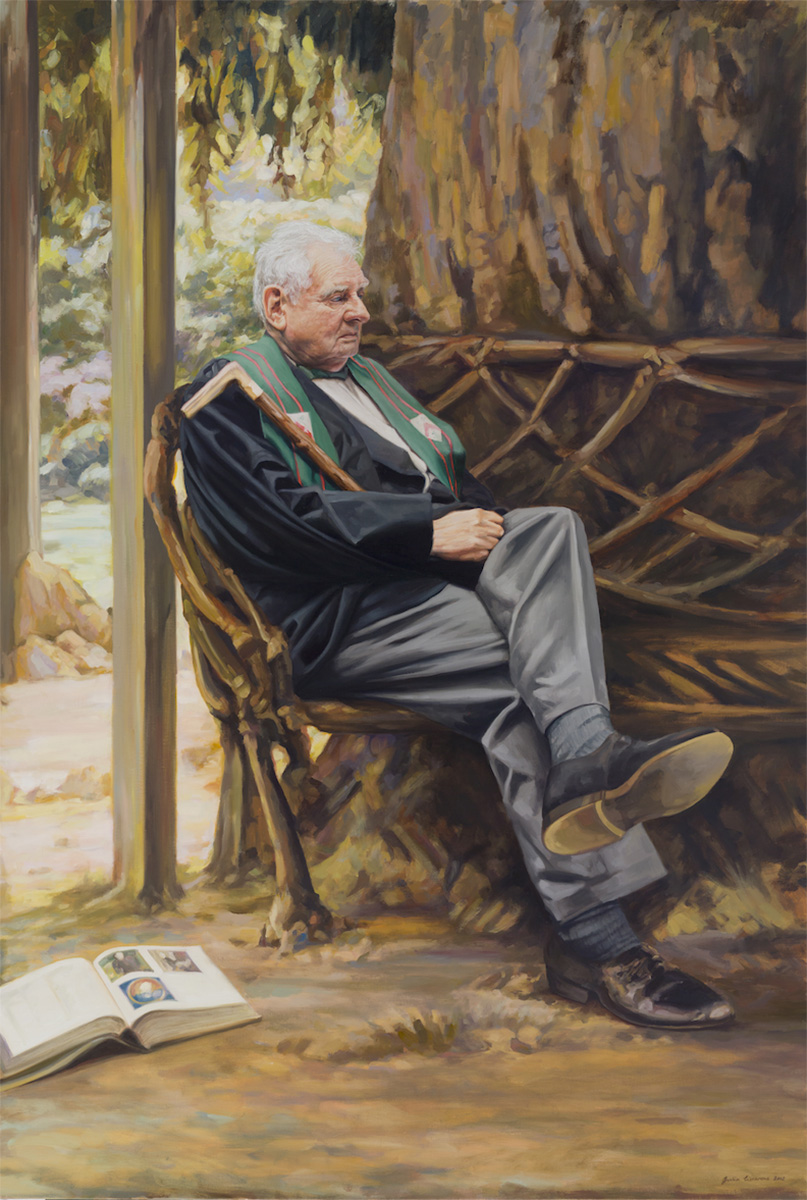 © the artist and Trinity College, the University of Melbourne
© the artist and Trinity College, the University of Melbourne
Professor John Poynter (TC 1948)
2012 Julia Ciccarone 1967 - oil on linen 141.3 x 97.2 cm [framed] AC 000654Historian and academic
Emminent historian Emeritus Professor John Poynter is deeply entwined within the histories of both Trinity College and The University of Melbourne. Poynter commenced at college, after attending Trinity Grammar School, Kew. He was awarded the 1951 Victorian Rhodes Scholarship before returning from Oxford in 1953 to take up the role as Trinity’s residential dean.
Throughout 1964-65, he took on additional responsibilties as Joint Acting Warden, until Robin Sharwood commenced as Trinity’s fourth Warden. In 1965, Poynter was installed as one of the college’s three inaugural Fellows. Appointed Ernest Scott Professor of History at The University of Melbourne (1966-75), he later became the university’s Deputy Vice-Chancellor (1975-90).
A prolific author, Poynter has written numerous histories and biographies, including on Russell Grimwade, the Miegunyah Bequests, philanthropist Alfred Felton, whose bequest assists the National Gallery of Victoria (NGV) and on Trinity’s first Warden, Dr Alexander Leeper.
Artist Julia Ciccarone has reimagined Poynter, her father-in-law, in the guise of John Longstaff’s portrait of Alfred Felton, held by the NGV. Felton’s newspaper is replaced with Poynter’s biography on the philanthropist, published for the centenary of Felton’s death in 1904.
Presented by John Poynter, 2012
Trinity College Art Collection
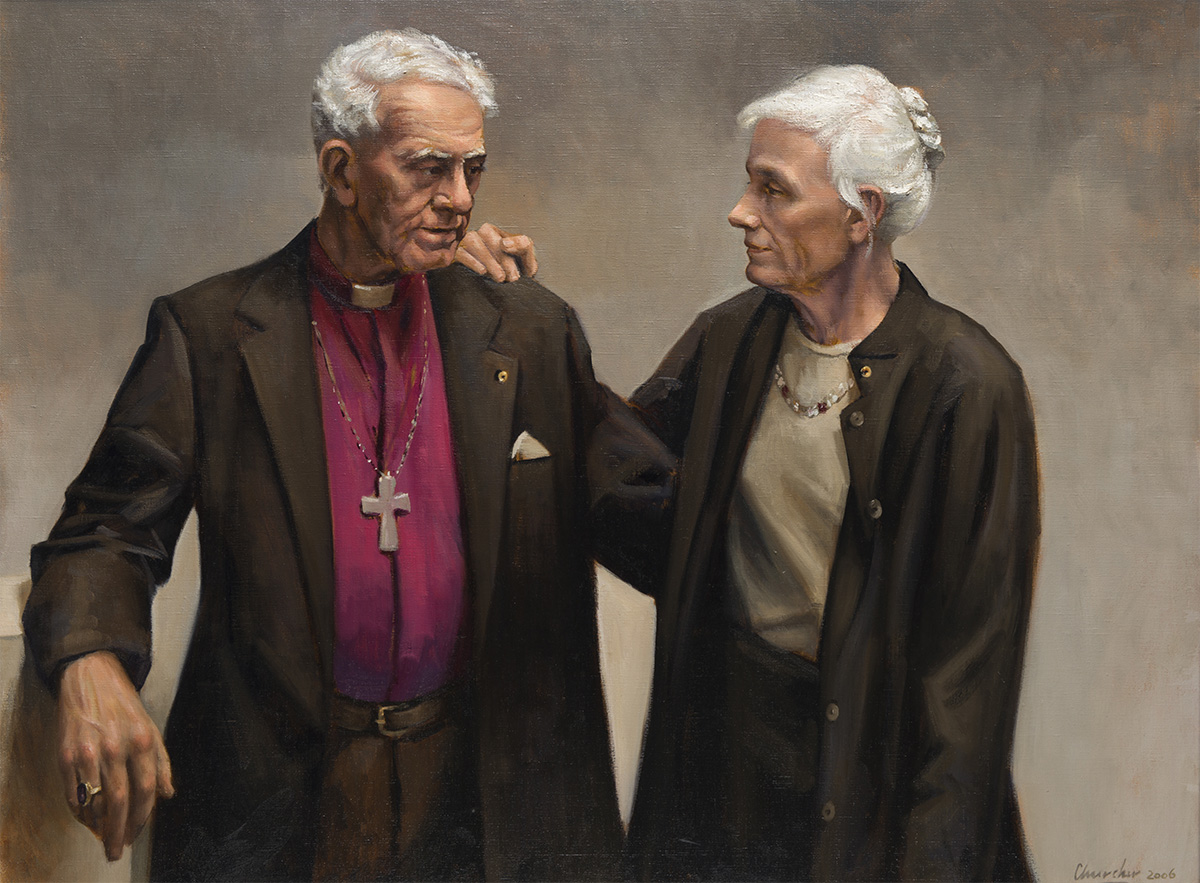 © the artist and Trinity College, the University of Melbourne
© the artist and Trinity College, the University of Melbourne
Right Rev James Grant (TC 1950) and Rowena Armstrong QC
2006 Peter Churcher 1964 - oil on canvas 104.5 x 134.5 cm [framed] AC 000284James Grant’s (1931-2019) association with Trinity College spanned almost 70 years. A non-residential student, and later theological student, he returned to college across a variety of roles; as chaplain, acting warden, bequest officer and historian, before his retirement in 2017.
He served as Bishop to the Western Region (1971-78) and Bishop of the Central Region (1978-85). From 1985 until his retirement from clerical roles in 1999, Grant was Dean of St Paul’s Cathedral, Melbourne.
Grant and Rowena Armstrong married in April 1983, when Armstrong was Victoria’s chief Parliamentary Counsel. Her expertise were invaluable in drafting the Trinity College Act 1978, and the college’s subsequent constitutions under that Act.
For their long-standing support, Grant and Armstrong were both elected as Senior Fellows of the college.
Provenance: Commissioned by the Trinity College Art Committee 2006
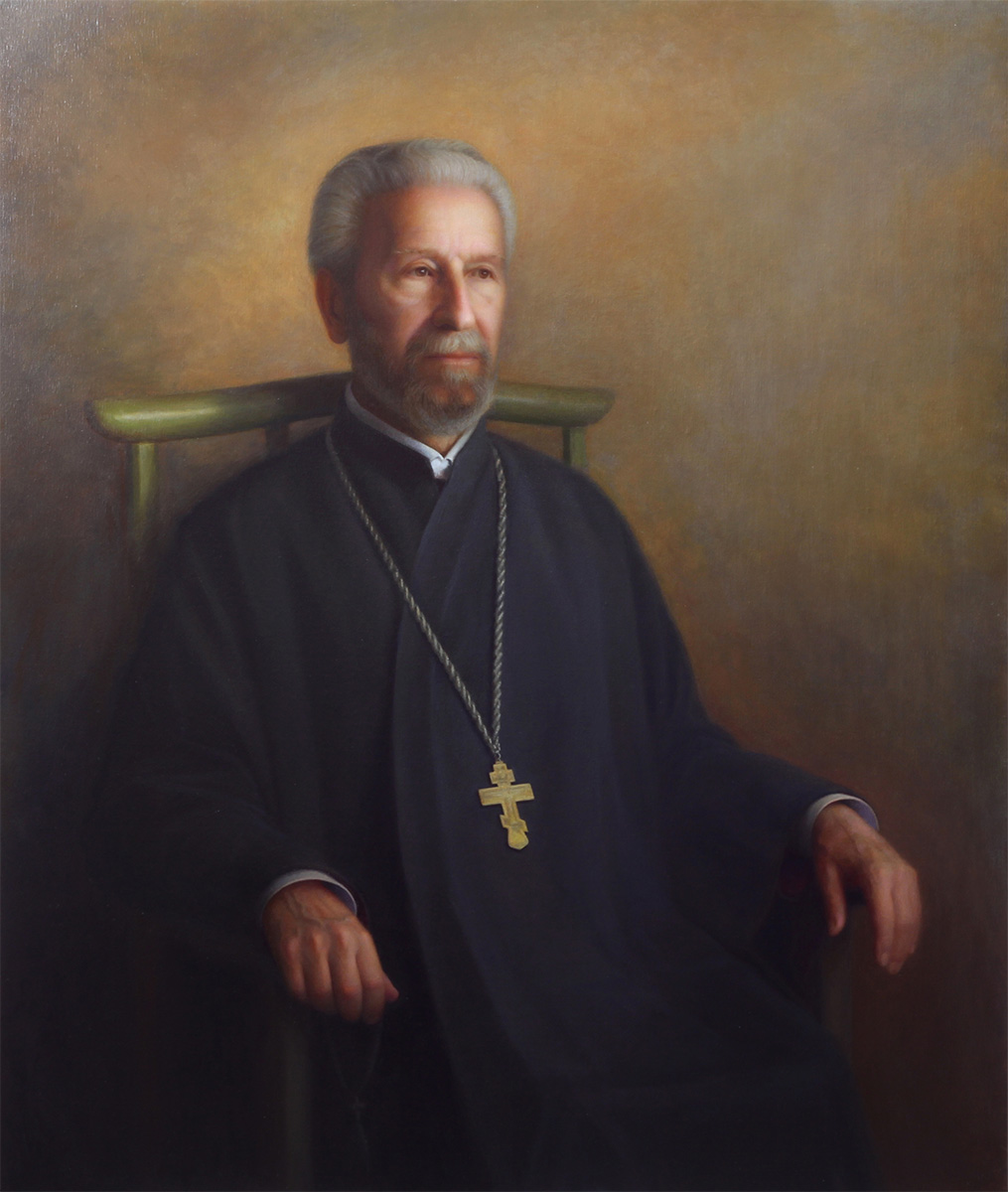 © the artist and Trinity College, the University of Melbourne
© the artist and Trinity College, the University of Melbourne
The Very Revd Father Miltiades Chryssavgis (TC 1952)
2014 Marcus Callum oil on canvas 109.8 x 94.2 cm [framed] AC 000701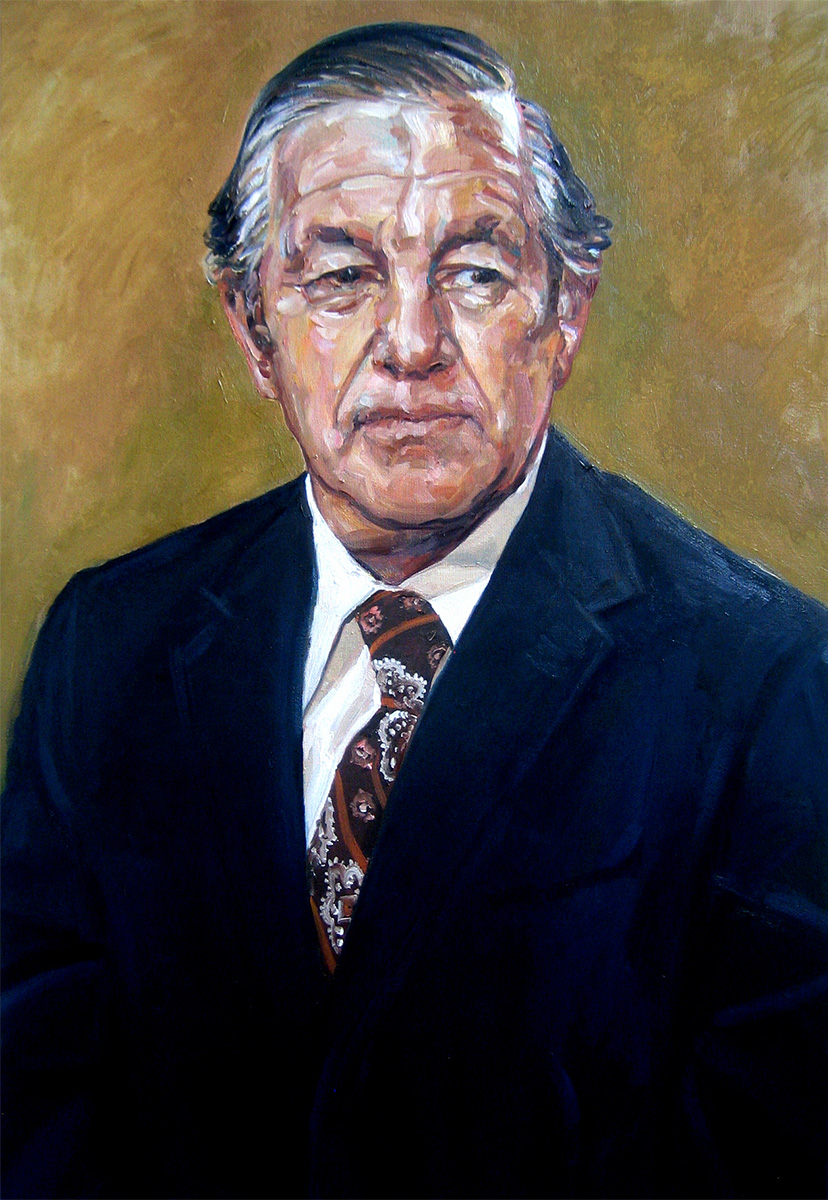 © the artist and Trinity College, the University of Melbourne
© the artist and Trinity College, the University of Melbourne
Sir Rupert James Hamer, AC, KCMG, ED (TC 1935)
2010 Lewis Miller 1959 - oil on linen 135.9 x 96.0 cm [framed] AC 000571Two Hamer brothers, Rupert and Alan, came in to Trinity a year apart in the mid-1930s. Alan would become Victoria’s Rhodes Scholar for 1938; Rupert, the state’s 39th premier.
Like many college alumni of the 1930s, Rupert Hamer served during World War II, throughout the Middle East,
New Guinea and in France. In the aftermath of war, he was elected to the Victorian Legislative Council in 1958, rising in the cabinet of liberal premier Henry Bolte to eventually assume the Deputy Premiership after the retirement of Arthur Rylah (TC 1928) in 1971. Bolte retired the following year, endorsing Hamer as his successor. Hamer won in a landslide again Labor in the 1973 state election.
As Premier, Hamer was progressive with an eye to the future, built upon the past. His creation of the Public
Records Act 1973, which gave rise to the Public Records Office, was followed by the Historic Buildings Act 1974.
A vocal advocate for the rights of women resulted in the Equal Opportunity Bill in 1976. A year later, Fay Marles
(JCH 1944) would become the first Equal Opportunity Commissioner.
Lewis Miller has a long and celebrated career, having won the Hugh Ramsay Portrait Prize in 1981, and the Archibald Prize in 1998. In 2017, Miller won the Rick Amor Self Portrait Prize with his work Vale St self portrait.
Presented by Lady April, Chris and Alan Hamer, 2010
Trinity College Art Collection
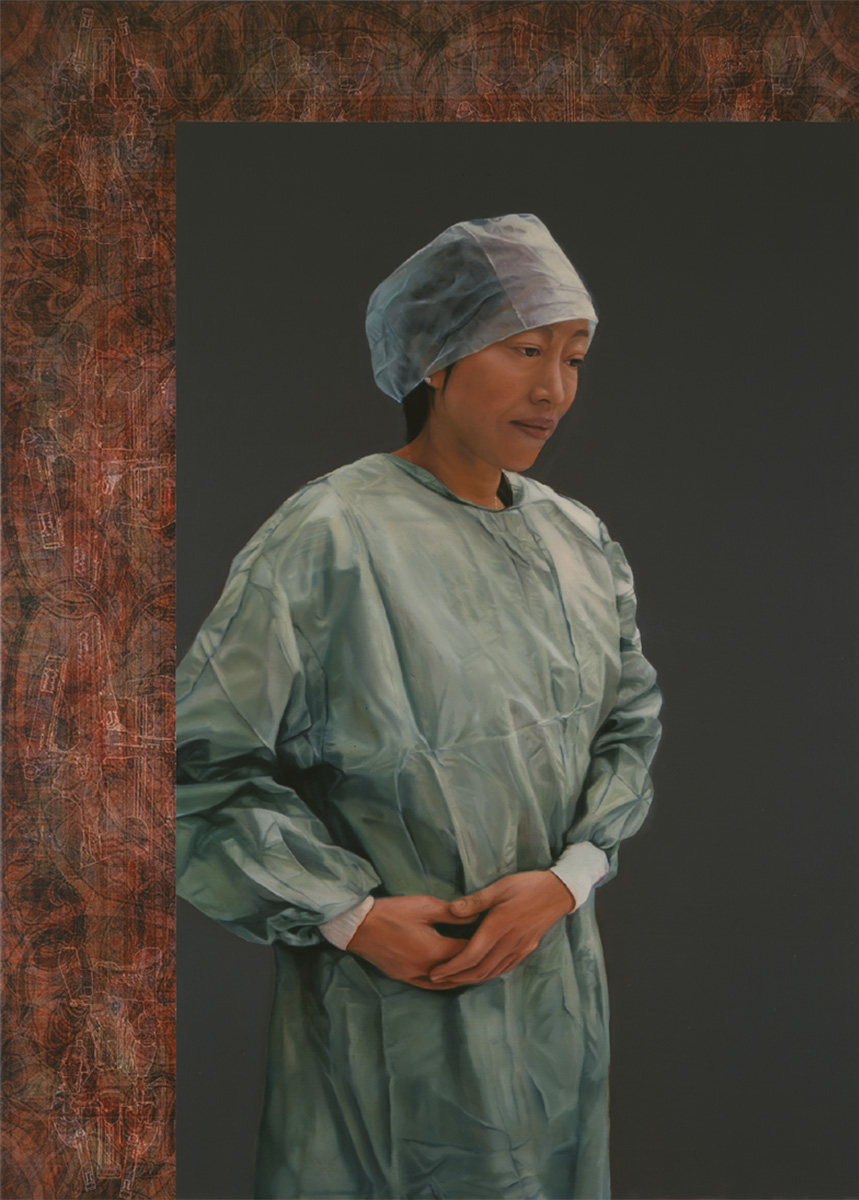 © the artist and Trinity College, the University of Melbourne
© the artist and Trinity College, the University of Melbourne
Dr Susan Lim (TC 1977)
2005 John Young 1956 - oil on canvas 156.0 x 114.0 cm [framed] AC 000183earlier attending the Singapore Chinese Girls’ School and the Raffles Institution.
In another broadening of the Fifth Warden Dr Evan Burge’s approach to a more diverse collegiate community, while in residence at Trinity, Lim was also a student at Monash University, rather than Melbourne, where she had been awarded a scholarship under the Colombo Plan in 1974.
She obtained her Fellowship of the Royal College of Surgeons in Edinburgh and a PhD in transplantation
immunology from Cambridge. She achieved renown after performing Singapore’s first successful liver transplant
in 1990, a scene evoked in Hong Kong-born artist John Young’s depiction of Lim. In 2004, Lim pioneered the da
Vinci Robotic General Surgery Program, transforming the field of minimally invasive surgery. Young has incorporated digital images produced by the da Vinci robotic system as the border to his painted portrait of Lim in her surgical scrubs.
Susan Lim was installed as a Fellow of Trinity College in 2005, with this commissioned portrait by the college’s Art
Committee recognising her career achievements and continued support of the college.
Commissioned by the Trinity College Art Committee, 2004
Trinity Collge Art Collection
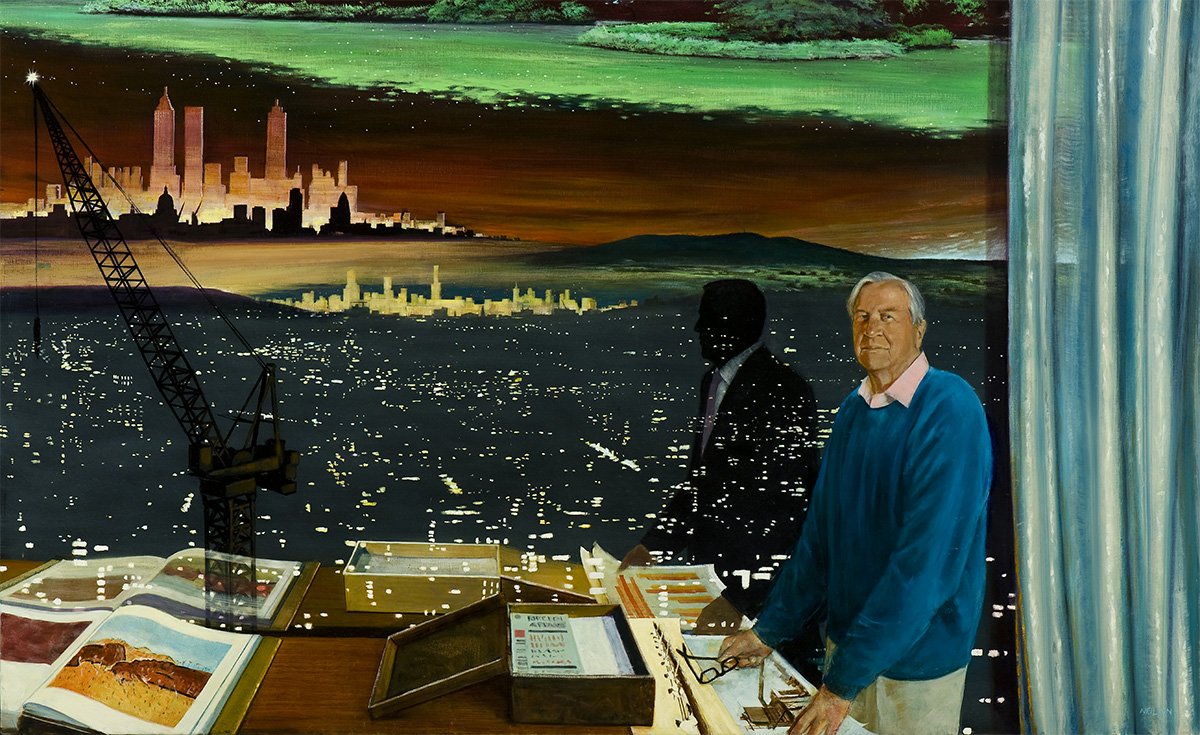 © the artist and Trinity College, the University of Melbourne
© the artist and Trinity College, the University of Melbourne
Sir Rod Carnegie AC (TC 1951)
2010 Peter Neilson 1944 - oil on canvas 132.0 x 152.4 cm [framed] AC 000604Carnegie had an engaged collegiate experience, both academically as well as on the sports field or on the water,
where he rowed for both college and university crews. Continuning his studies at Oxford, where he was President
of the Oxford University Boat Club, and Harvard (MBA 1959), he returned to found the Australia practice of
McKinsey in Melbourne in 1963. By 1967, he had returned to New York to become Director of the company.
Peter Neilson’s portrayal of Carnegie assembles his multifaceted life on canvas, a notable departure from many
earlier college ‘head-and-shoulder’ portraits. The skylines of New York, London and Melbourne, where Carnegie’s
career took him, are set against the refreshing green of his farm property at Mount Macedon. His passion for rowing appears in the photograph on the desk before him; an open book on artist Fred Williams speaks to Carnegie’s role in faciliating Williams’ travels to the Pilbara in 1979.
Despite an ostensibly business career, only Carnegie’s reflection in the glass is suitably attired. Neilson instead
depicts Carnegie in casual clothing, a draped curtain at the artwork’s right edge alluding to the theatre of life, and
the subsequent acts yet to be performed.
Presented by Sir Roderick Carnegie, 2010
Trinity College Art Collection
 © the artist's estate and The University of Melbourne
© the artist's estate and The University of Melbourne
Ada Mary a'Beckett (TC 1892)
Charles Wheeler 1880 - 1977 oil on canvas 1948.0024.000.000Born in Adelaide, Ada Mary a’Beckett (TC 1892) was witness to the battles fought for equality in education in
the final decades of the nineteenth century. She came to Trinity in her second year, as an Annie Grice Scholar, before graduating in science in 1895, a Master’s degree following two years later.
‘There was more real social and cultural life at the University in the ‘90’s than there is today’, she reflected in 1948. She was seated in Wilson Hall in 1893 when the first female graduates were conferred with medical degrees, Trinity student Lilian Alexander (TC 1883) among them, and later founded the Victorian Women Graduates’ Association.
In 1901, a’Beckett became the first women to lecture at The University of Melbourne. In 1908, she established the Free Kindergarten movement for which, in 1935, she was recognised as a Commander of the Order of the British Empire. Working as a teacher at Melbourne Girls Grammar School, she later became head of biology at Scotch College. She served as chair of the Janet Clarke Hall Committee for two periods, 1923-26 and in 1928.
Charles Wheeler was commissioned in 1947 to paint a’Beckett for the Free Kindergarten Union, the work being presented in March the following year. Suffering from cancer, a’Beckett died months later, in May 1948.
Presented by the Committee of the Ada Mary a'Beckett Free Kindergarten, 1948
On loan from the University of Melbourne
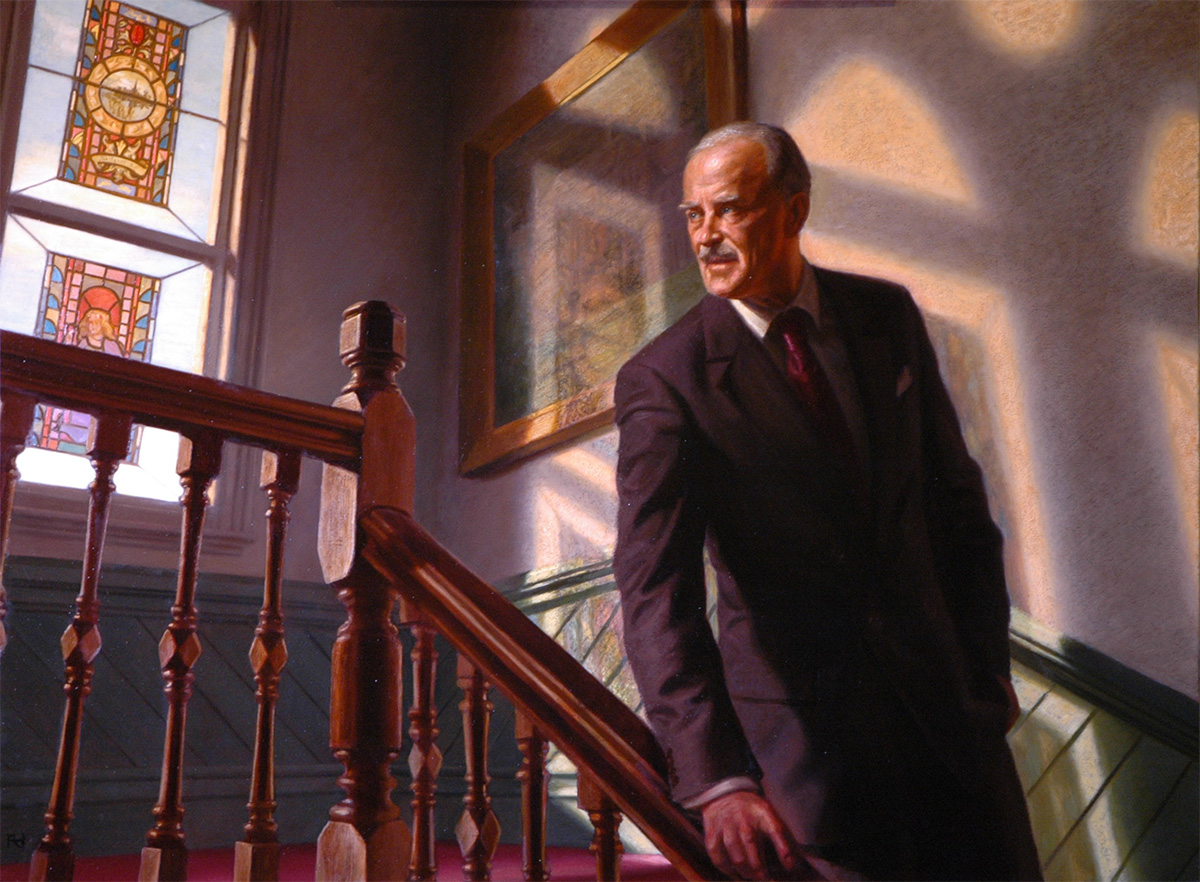 © the artist and Trinity College, the University of Melbourne
© the artist and Trinity College, the University of Melbourne
Lord Richard Casey KG, GCMG, CH, DSO, MC, PC (TC 1909)
2007 Ralph Heimans 1970 - oil on canvas 118.7 x 151.8 cm [framed] AC 000192 © the artist and The University of Melbourne
© the artist and The University of Melbourne
Alice Hoy (TC 1919)
1984 Chris White 1949 - oil on canvas 1984.0252.000.000Educationalist and inaugural principal of the Secondary Teacher's College
Alice Hoy was born on 9 February 1893 in the Victorian township of Ararat, the eleventh and youngest child of her blacksmith father and Irish-born mother. Her earlier schooling at Kensington State and University High schools and her evident academic talent saw her enter Trinity College Women's Hostel in 1911 while studying at the University of Melbourne.
At the end of her first year, she had both gained first-class passes and won exhibits in deductive logic, elementary pyschology and English. 'Miss Hoy, who is not yet out of her teens, gives every promise of a brilliant career', the Ararat Advertiser wrote at the time.
Hoy completed her Bachelor of Arts (1914), graduating with first-class honours, winning the Wyselaskie scholarship in political economy and the Dwight prize in history. She followed this with a Diploma of Education (1915) and then a Masters of Arts (1916). She returned to Trinity at the end of the First World War, joining staff as Lecturer in History and Economics. She would return to study a decade later to undertaken a Bachelor of Laws (1927).
A firm believer in the enabling power of education, Hoy was appointed the first principal of the Secondary Teachers’ College in 1950. In response to a letter of congratulations from the Victorian women Graduates’ Association, Hoy’s professionalism is evident: 'I hope that for the same of my sex as well as for other reasons I shall not manage it too badly.'
Alice Hoy influenced education in Victoria for over fifty years and, following her retirement in 1958, continued to be recognised with a number of accolades, being made an honorary fellowof the Australian College of Education (1960) and being appointed an OBE in 1964. The Australian and New Zealand Association for the Advancement of Science awarded her the Mackie medal in 1967 and Monash University conferred an honorary LL.D. on her in 1972, four years before she died.
On loan from the University of Melbourne
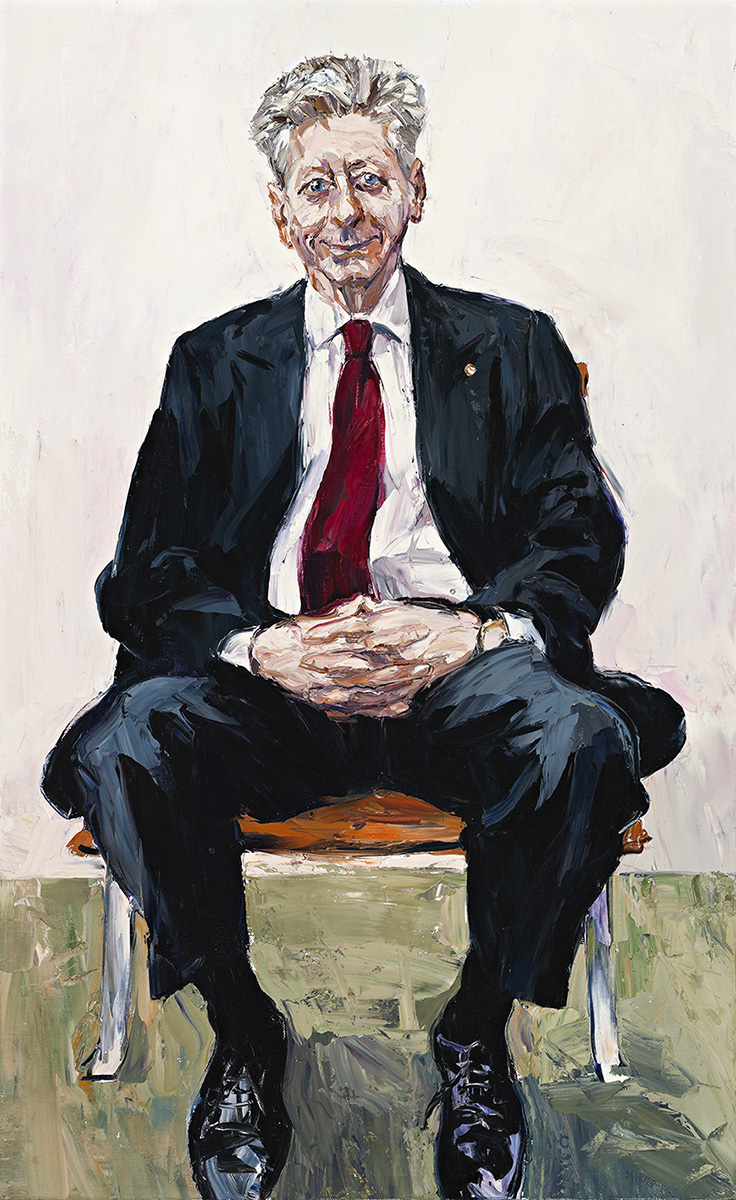 © the artist and Trinity College, the University of Melbourne
© the artist and Trinity College, the University of Melbourne
William Cowan AM (TC 1963)
2017 Nicholas Harding 1956 - 2022 oil on linen 134.5 x 84.0 cm [framed] AC 000752corporate experience, having held numerous executive positions. Cowan now spearheads Directioneering, a firm that assists senior executives build their careers.
At the conclusion of his term as Board Chair, Trinity College established The Bill Cowan Award in his honour,
presented annually to a college alumnus or alumna in recognition of outstanding achievements in the year
preceeding.
In 2017, Nicholas Harding was approached to undertake a commissioned portrait of Cowan. More familiar amongst Sydney’s arts and music scene, Cowan’s black business attire was only the artist’s second such ‘suit’ portrait.
Exhibited at the National Portrait Gallery, Canberra, later that year, it was noted that: ‘Unexpectedly, and largely
because of Cowan’s attitude, this painting of a corporate man turned out to be one of Harding’s zestiest-ever
portraits.’
Having initially overcome a battle with cancer, Harding sadly succumbed to the illness last year when it returned,
only months after having won the Wynne Prize for best Australian landscape painting.
Commissioned by the Trinity College Board, 2017
Trinity College Art Collection
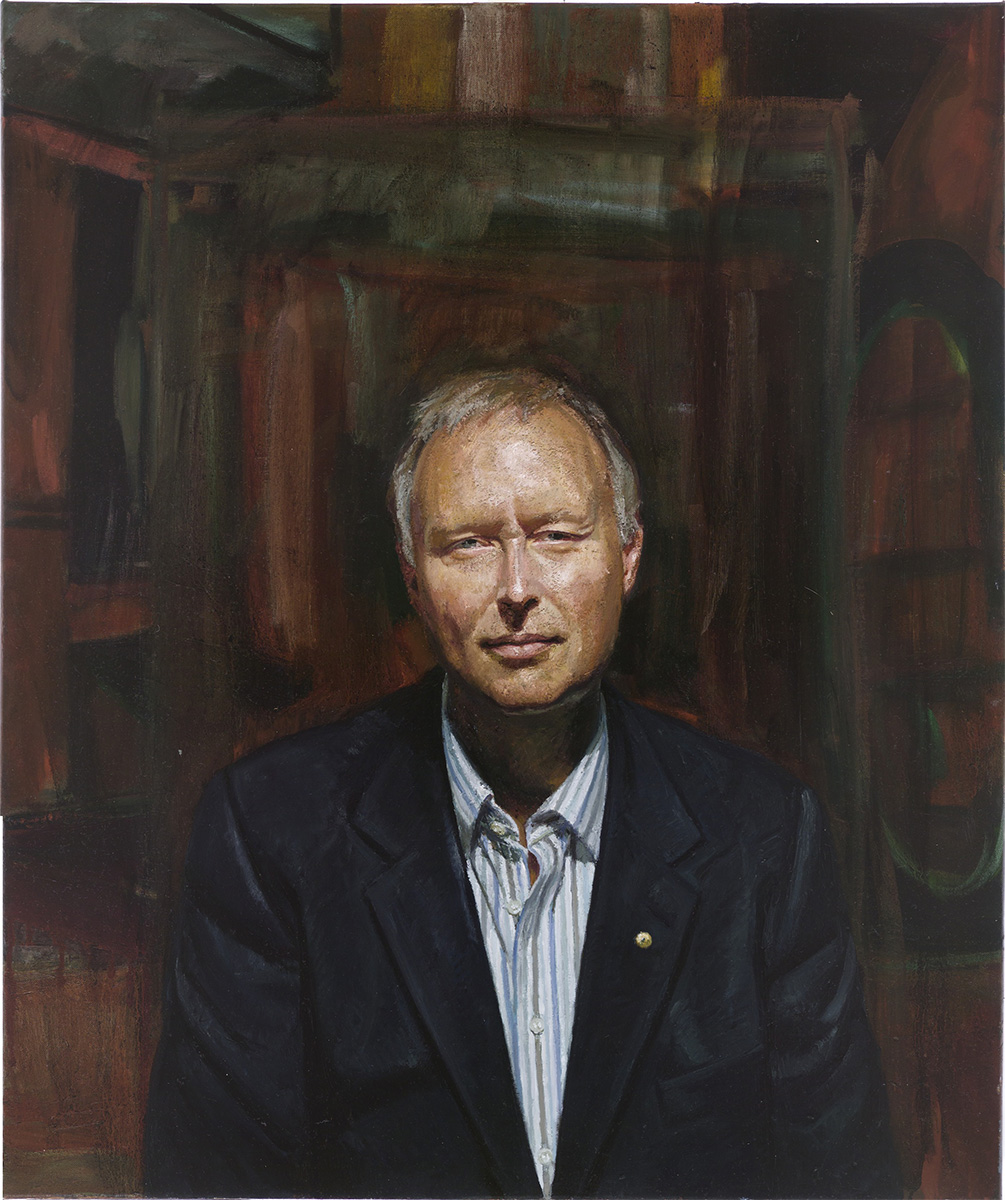 © the artist and Trinity College, the University of Melbourne
© the artist and Trinity College, the University of Melbourne
Rupert Myer AO (TC 1976)
2012 Yvette Coppersmith 1980 - oil on canvas 102.0 x 86.6 cm [framed] AC 000653He has served on numerous boards, both in chairship as well as member roles, including the National Gallery of
Victoria, the Museum of Contemporary Art, Sydney, Opera Australia Capital Fund, Kaldor Public Art Projects, among others. In mid-2015, his was elevated to an Officer of the Order of Australia.
In early 2023, Myer succeeded fellow Trinity alumnus Sir Andrew Grimwade (TC 1949) to become Chair of the
Felton Bequests’ Committee, a body established through the philanthrophy of Alfred Felton in 1904.
Specialising in portraiture and abstractionism, artist Yvette Coppersmith graduated from the Victorian College of the Arts in 2001. Since then, she has explored various styles from photo realism to her present, richly tactile approach.
In 2018, having been a finalist five times prior, she became the 10th woman to win the Archibald Prize since it was
established in 1921, with her work, Self-portrait, after George Lambert. Coppersmith continues to be one of the leading, female portrait artists in Australia.
Commissioned by the Trinity College Art Committee, 2011
Trinity College Art Colllection
 © the artist and Trinity College, the University of Melbourne
© the artist and Trinity College, the University of Melbourne
Professor Kevin Westfold (TC 1940)
1968 Irene Hill 1916 - 2009 oil on canvas 123.0 x 103.0 cm [framed] AC 000242Mathematician and radio astronomer of considerable distinction, Kevin Westfold entered Trinity College in 1940,
from Melbourne Grammar School, on the Charles Hebden scholarship. He gradauted with a Bachelor of Arts (Hons) in mathematics in 1942, Bachelor of Science in 1943, and Masters in Arts in 1946. A keen sportsman at college, he was elected Senior Student in 1943.
A CSIRO Overseas Scholarship took him to Oxford where he worked on theoretical problems of radio astronomy, in which he was awarded his doctorate in 1951. Returning to Australia, he worked in Sydney with CSIRO before joining staff at the University of Sydney in Applied Mathematics.
In 1960, he became the first Professor of Mathematics at Monash University, then dean of the Faculty of Science (1962-75), and Deputy Vice-Chancellor from 1982 to 1986. Throughout his career, he chaired numerous advisory
bodies to both state and federal governments on issues pertaining to astronomy. In 1992, he was installed a Fellow of Trinity College, the same year he returned to college as a residential tutor in physics and mathematics.
A student of the National Gallery School and winner of the 1940 Bernard Hall Prize, Irene Hill’s portrait of Westfold
was entered in the 1968 Archibald Prize. Due to renovation works at the Art Gallery of NSW that year, there was no exhibition and only the winning portrait was displayed.
Presented by Kathy Westfold, 2004
Trinity College Art Collection
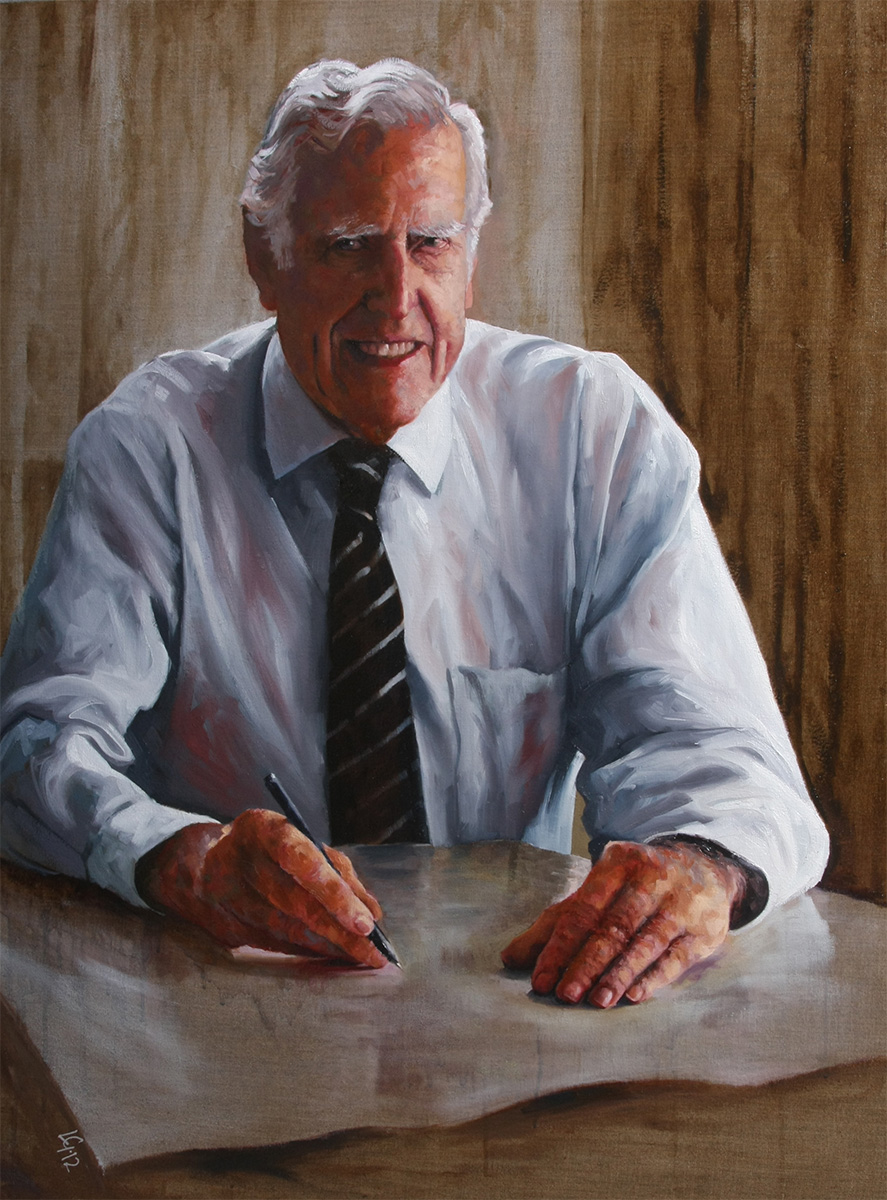 © the artist and Trinity College, the University of Melbourne
© the artist and Trinity College, the University of Melbourne
Neil Everist OAM (TC 1951)
2012 Lianne Gough oil on canvas 119.0 x 90.3 cm [framed] AC 000655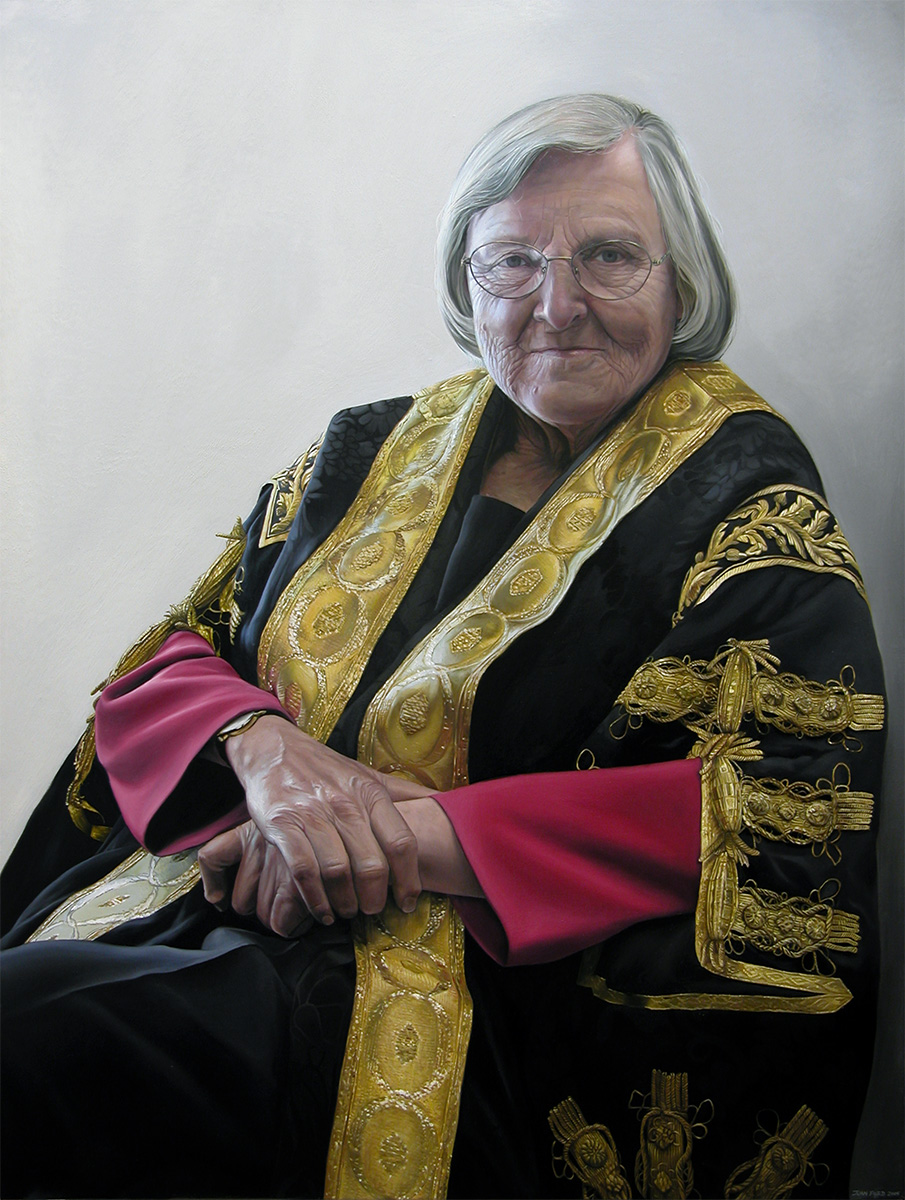 © the artist and Trinity College, the University of Melbourne
© the artist and Trinity College, the University of Melbourne
Fay Marles AM (JCH 1944)
2005 Juan Ford 1972 - oil on linen 142.1 x 111.6 cm [framed] AC 0001811944. She graduated four years later with a Bachelor of Arts and Diploma of Social Work from The University of
Melbourne, subsequently working as a social worker in Queensland.
Her marriage to Donald Marles in 1952 however meant she was subjected to the marriage bar, and forced to resign her position; a situation that no doubt contributed to her later advocacy against such inequalities.
Between 1977 and 1987, Marles served as Victoria’s first Commissioner of Equal Opportunity, a role established
by Trinity alumnus and then premier, Rupert Hamer. A year before she retired from the role, she was awarded a
Member of the Order of Australia for her public service, particularly in the field of social welfare.
In 2001, Fay Marles AM was installed as the first female Chancellor of The University of Melbourne in its 150-year
history, succeeding Sir Edward Woodward.
Renowned for his hyper-realism, Juan Ford’s compelling portrait presents an unfliching Marles, in the regalia of her
academic office, seemingly defying those who had earlier challenged her right to work as a woman. In 2004, Ford won the Geelong Gallery’s Fletcher Jones Art Prize.
Commissioned by the Trinity College Art Committee, 2004
Trinity College Art Collection
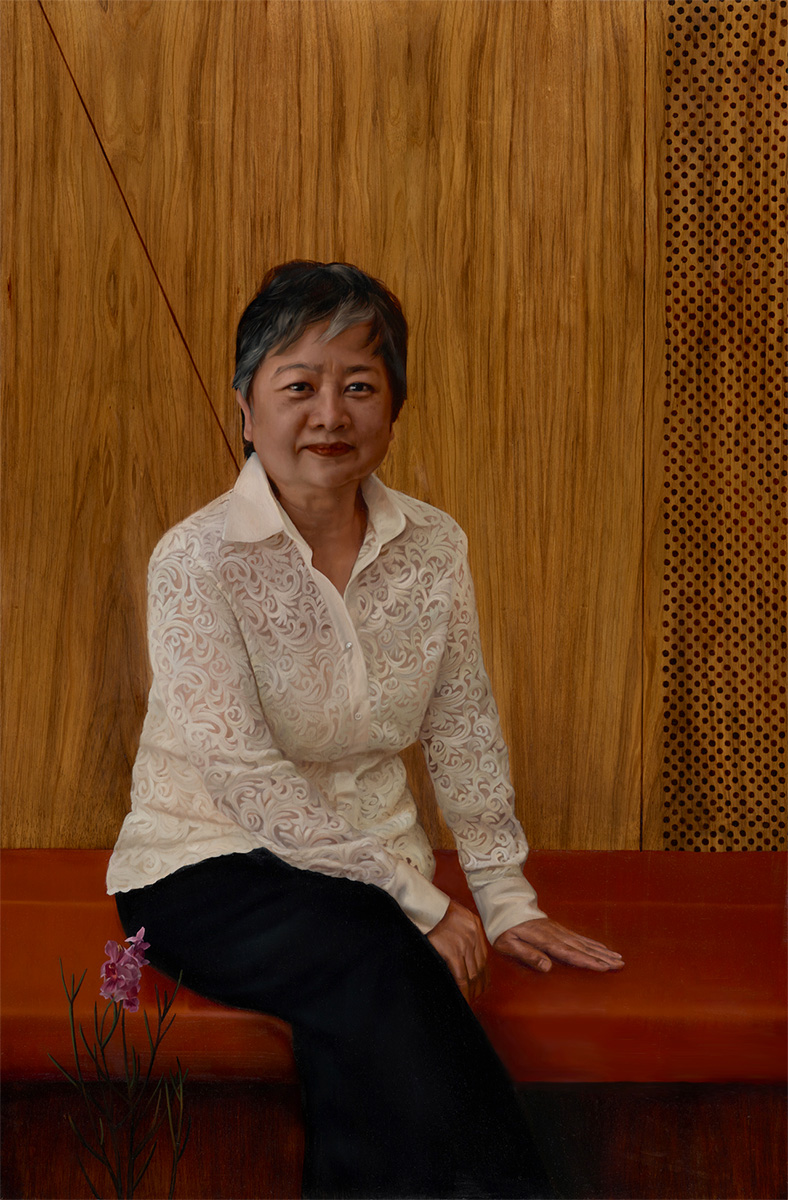 © the artist and Trinity College, the University of Melbourne
© the artist and Trinity College, the University of Melbourne
Serene Yong
2018 Effie Pryer 1989 - oil on blackwood veneer on board 124.4 x 82.8 cm [framed] AC 000773Trinity College since 1992, helping the college build the international student base of its successful Foundation
Studies program.
Over more than 30 years, she has been a driving force in guiding young Singaporeans to consider Trinity and The
University of Melbourne as their preferred educational provider. Throughout the 1990s, she worked closely with
the program’s Executive Director Denis White, who was introduced to her while looking for a Singaporean agent.
‘Yong was without peer as an education agent’, White later wrote. ‘As an education agent - and a human being with a committment to education and care for her fellow human beings - Yong was always the benchmark.’
Although based in Singapore, Hobart-based artist Effie Pryer has depicted Yong seated in front of the blackwood timber veneer of the college’s Gateway Building, the flagship teaching centre for Trinity’s Foundation Studies
program. Extending upon this, the work is itself painted on thin backwood veneer, incorporating the Vanda Miss Joaquim orchid, Singapore’s national flower.
Pryer was a finalist in the 2017 Black Swan Portraiture Prize, and currently works as a conservator at MONA, Hobart.
Commissioned by the Trinity College Board, 2018
Trinity College Art Collection
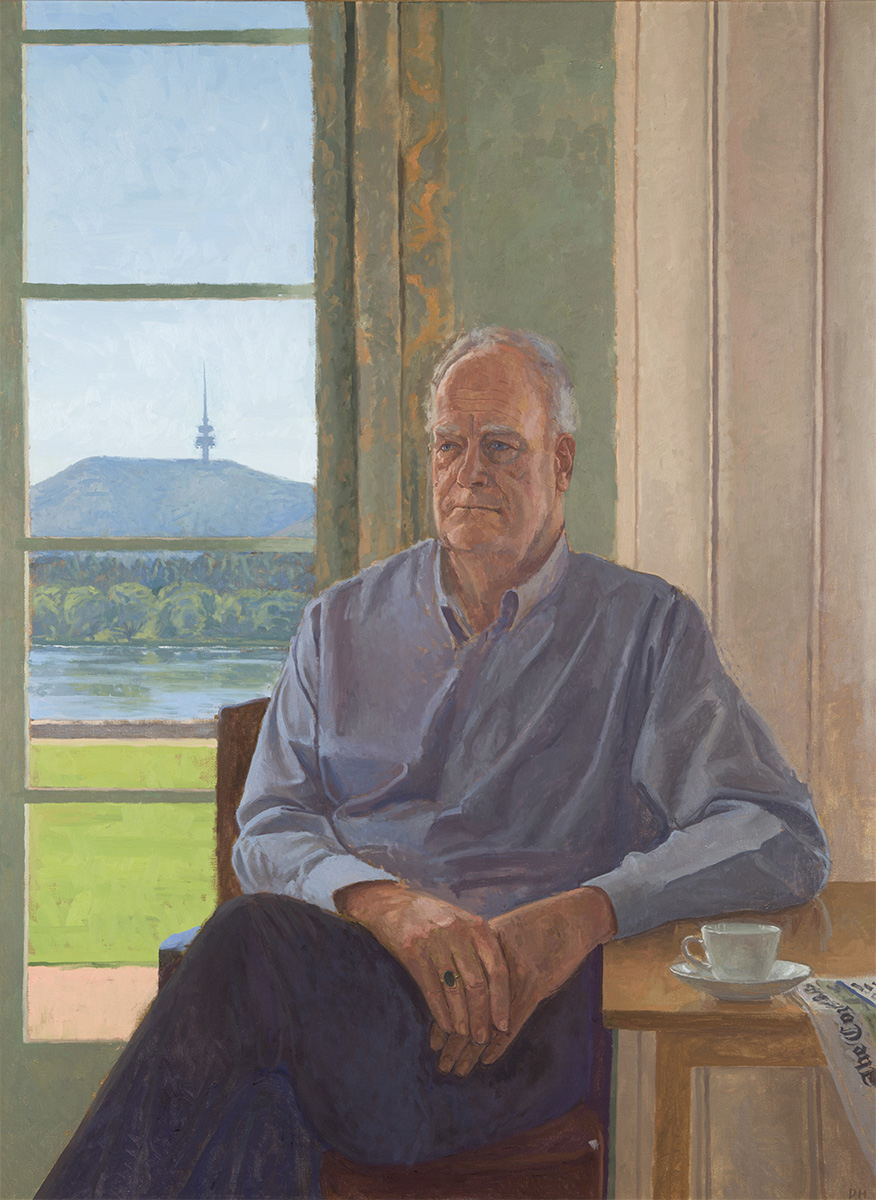 © the artist and Trinity College, the University of Melbourne
© the artist and Trinity College, the University of Melbourne
Right Rev the Hon Dr Peter Hollingworth AC OBE (TC 1955)
2002 David Henderson 1960 - oil on canvas 141.6 x 110.0 cm [framed] AC 000138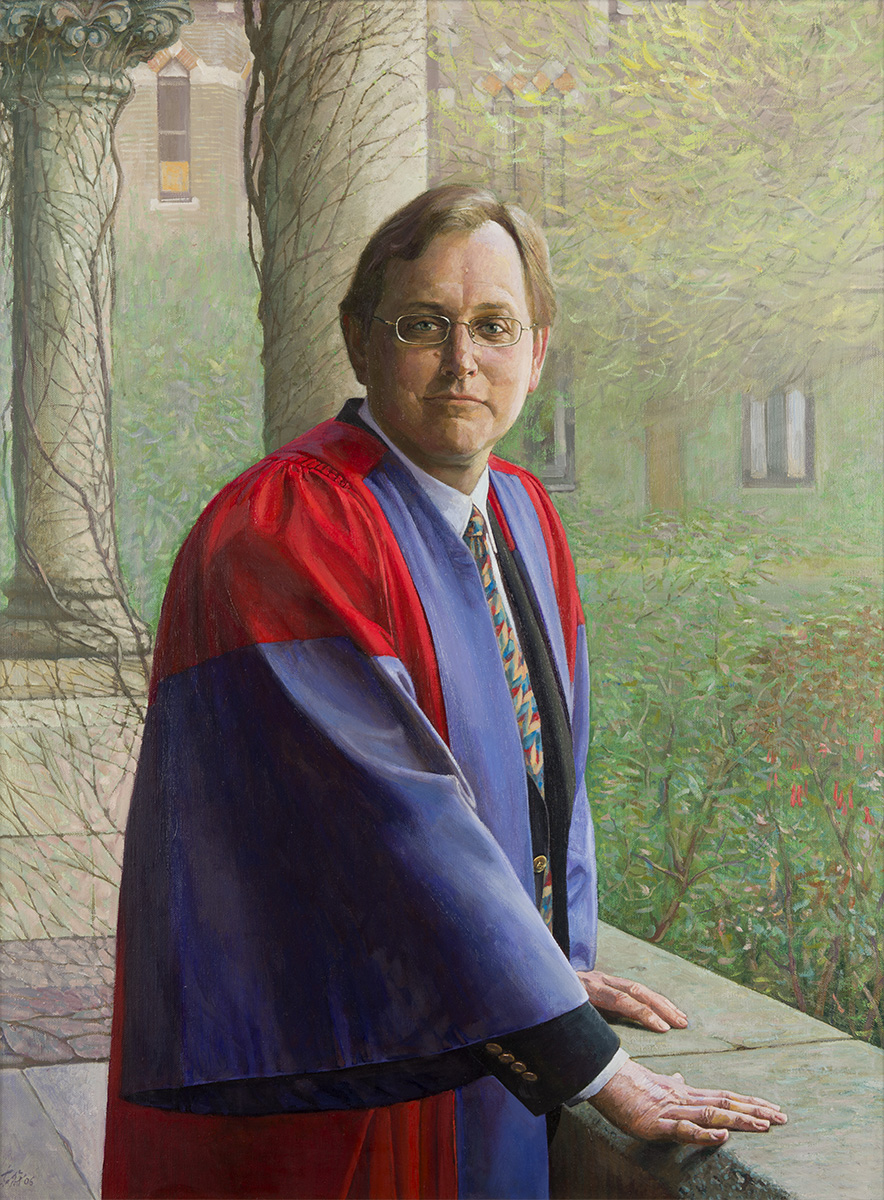 © the artist and Trinity College, the University of Melbourne
© the artist and Trinity College, the University of Melbourne
Dr Donald Markwell
2002 Jiawei Shen 1948 - oil on canvas 137.5 x 107.7 cm [framed] AC 000138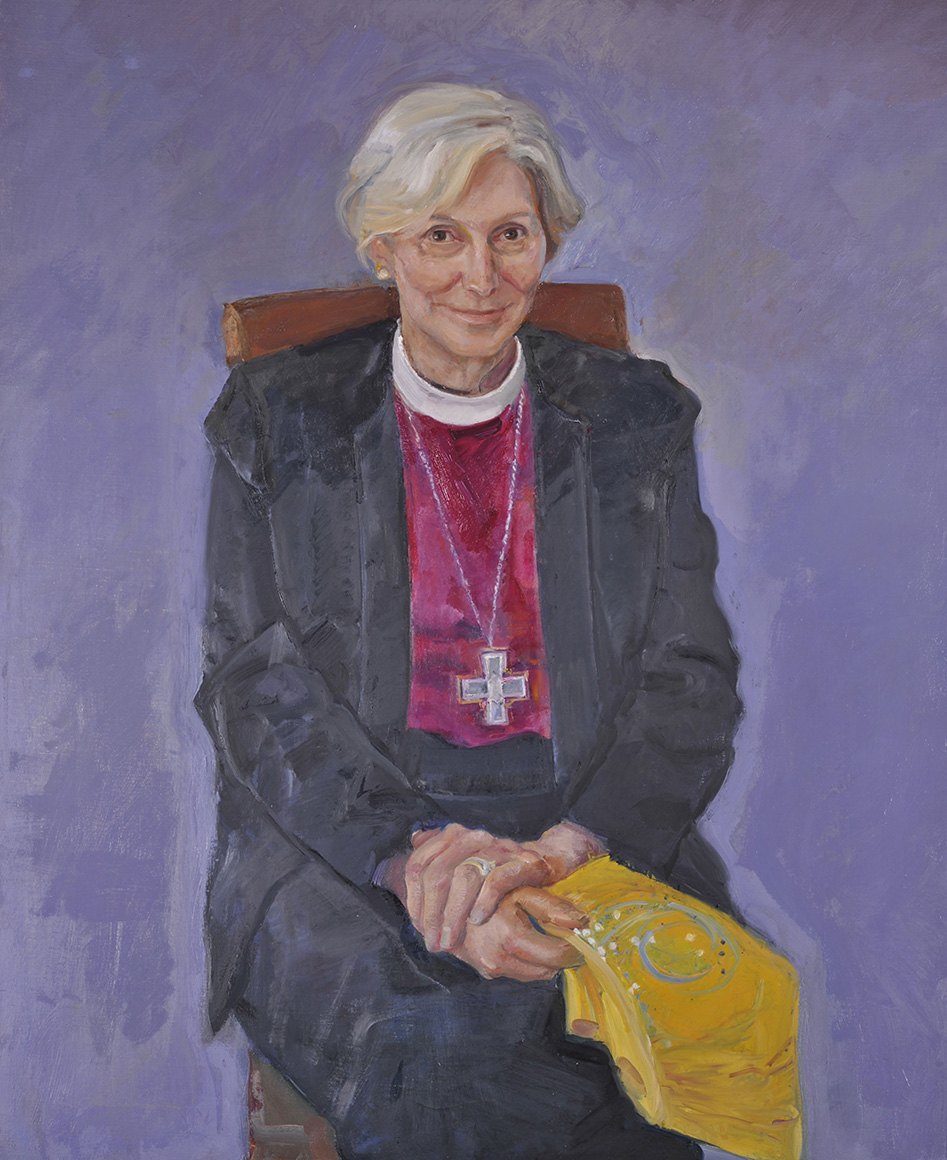 © the artist and Trinity College, the University of Melbourne
© the artist and Trinity College, the University of Melbourne
Most Rev Kay Goldsworthy AO (TC 1981)
2015 Peter Wegner 1953 - oil on canvas 118.1 x 97.9 cm [framed] AC 000702Goldworthy’s ecclesiastial life reads as a life of ‘firsts’. From 1980, she studied theology at Trinity College Theological School, less than a decade after the college had moved to co-residency. After her ordaination as one of the church’s first female deacons in 1986, she served as curate in parishes around Melbourne’s north and north-western suburbs. In 1992, she was among the inaugural group of women ordained as Anglican priests in Australia by the then Archbishop of Perth, Peter Carnley (TC 1962).
In early 2015, Goldsworthy was installed as the Bishop of Gippsland. Two years later, her distinguished service ‘as a pioneer and role model for women’, church administration, and pastoral care and equality, were honoured through her being awarded as an Office of the Order of Australia (AO). She was made a Fellow of Trinity College in 2022.
Winner of the 2021 Archibald Prize, acclaimed artist Peter Wegner’s portrait of Goldsworthy is imbued with veiled significance. Her yellow bishop mitre was an earlier gift by the donors who supported this commission, friends of the subject who remained anonymous until its unveiling.
Trinity College Art Collection
Commissioned by the Trinity College Art Committee, 2014
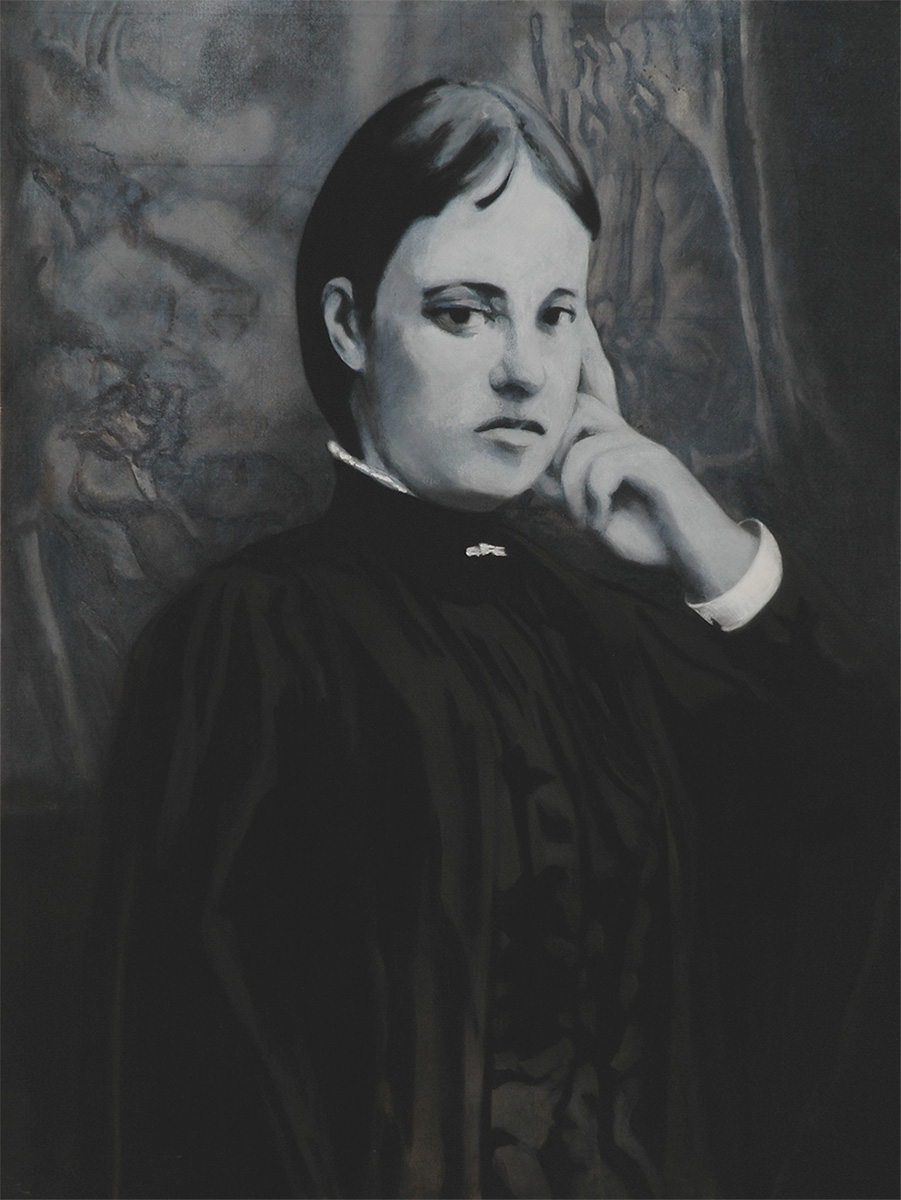 © the artist and Trinity College, the University of Melbourne
© the artist and Trinity College, the University of Melbourne
Helen Alexander (TC 1883)
2005 Caroline Williams 1945 - oil and pencil on linen 125.8 x 95.3 cm [framed] AC 000184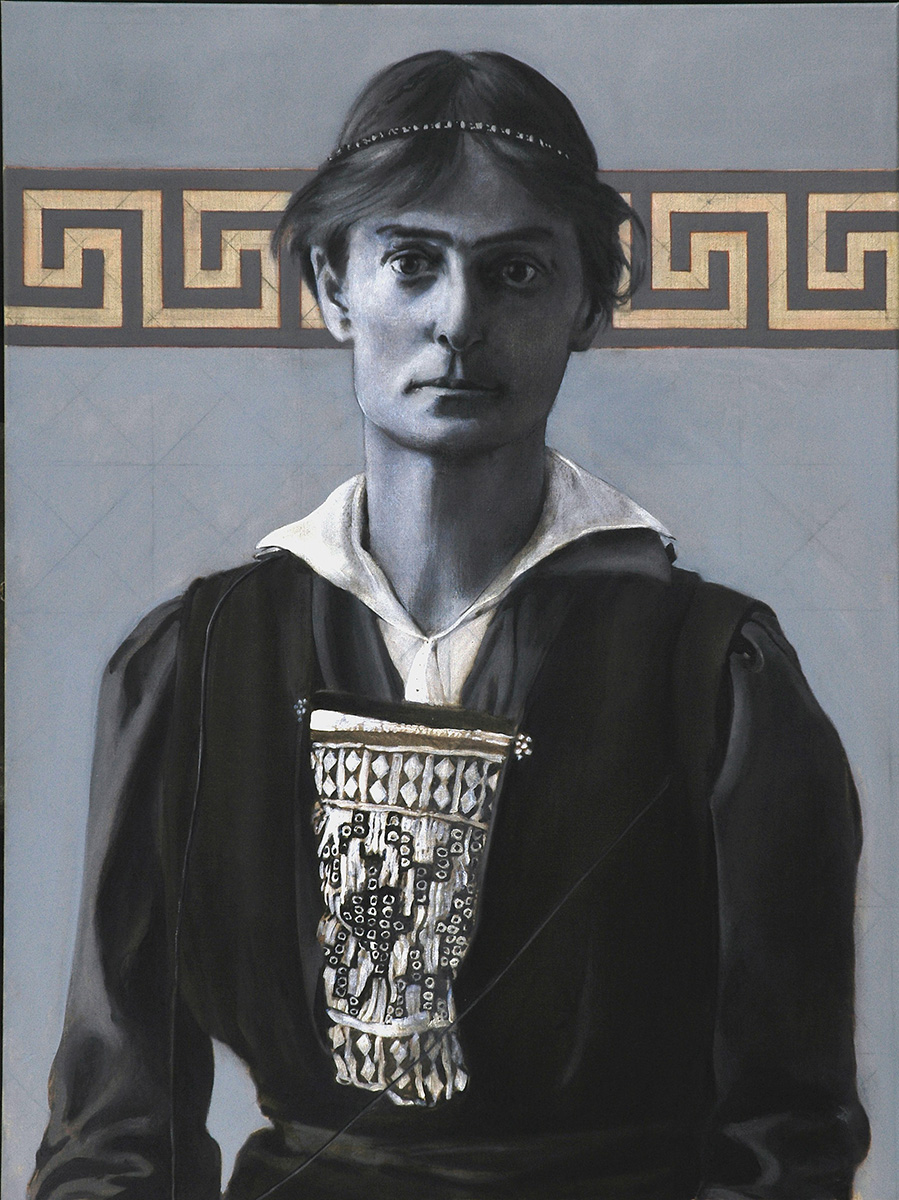 © the artist and Trinity College, the University of Melbourne
© the artist and Trinity College, the University of Melbourne
Florence Melian Stawell (TC 1886)
2005 Caroline Williams 1945 - oil and pencil on linen 125.8 x 95.3 cm [framed] AC 000185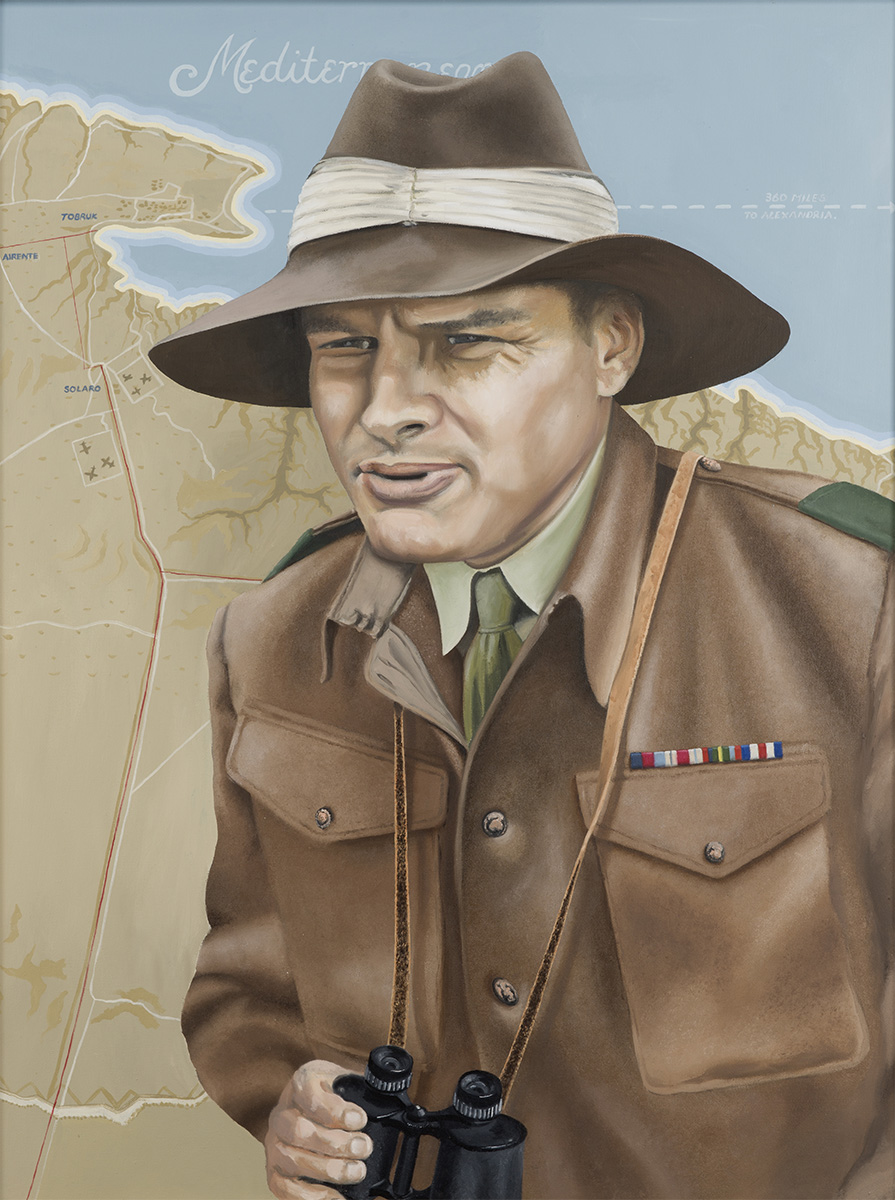 © the artist and Trinity College, the University of Melbourne
© the artist and Trinity College, the University of Melbourne
Reginald William Winchester 'Chester' Wilmot (TC 1931)
2009 Mary-Ann MacKenzie oil on canvas 105.2 x 86.0 cm [framed] AC 000564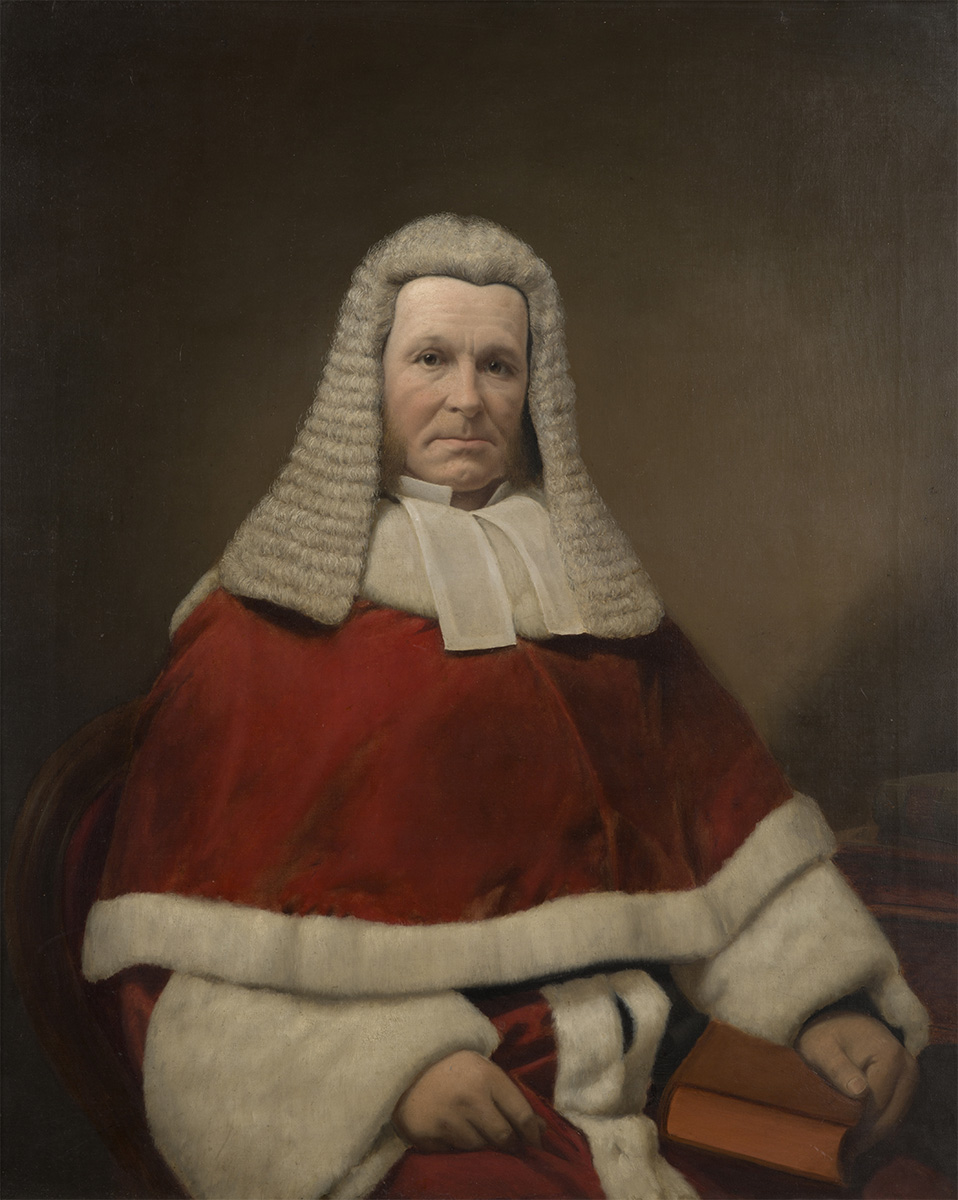 © Trinity College, the University of Melbourne
© Trinity College, the University of Melbourne
Sir William Stawell
1872 unidentified artist oil on canvas 99.3 x 86.8 cm [framed] AC 000486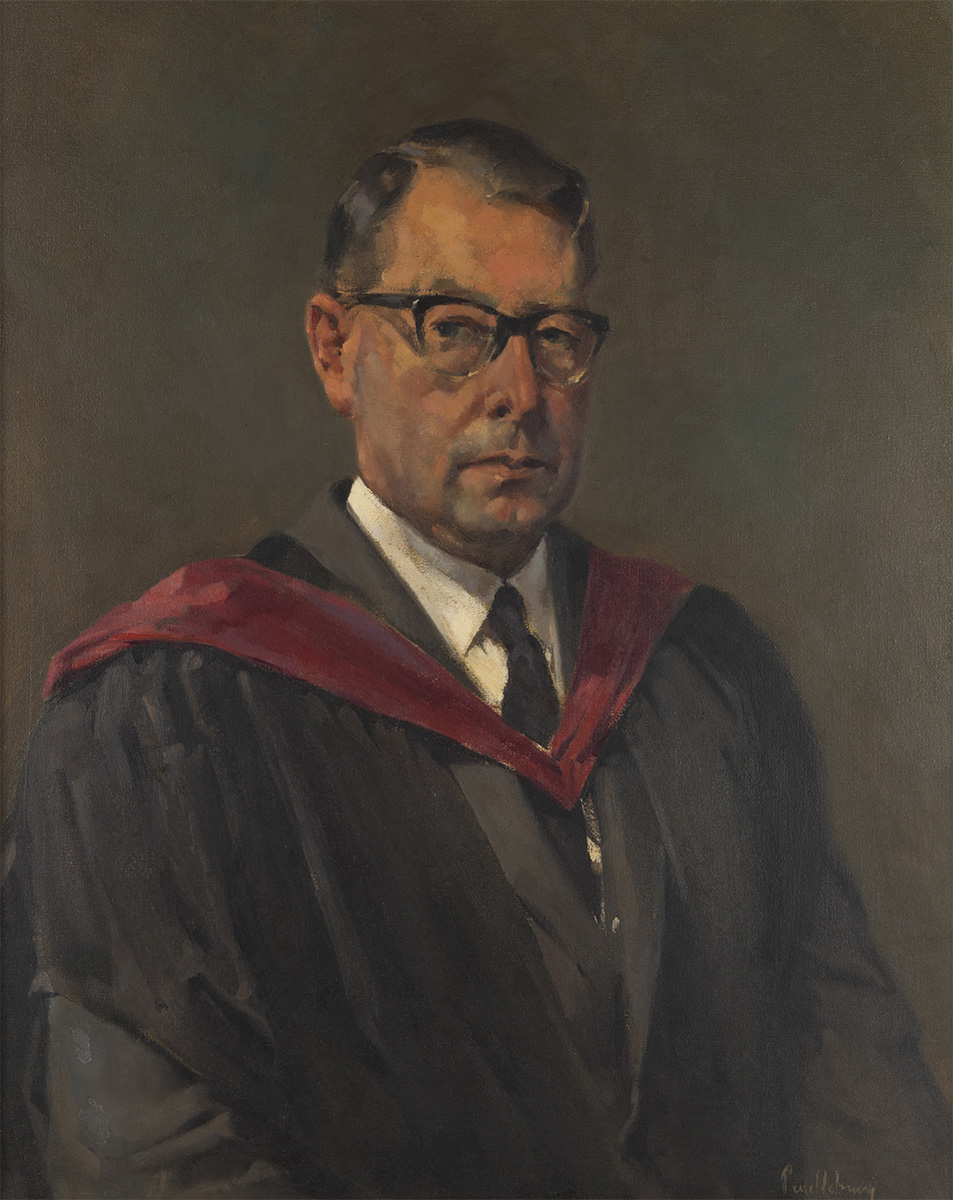 © the artist's estate and Trinity College, the University of Melbourne
© the artist's estate and Trinity College, the University of Melbourne
Ronald William Trafford Cowan
1963 Laurence Pendlebury 1914 - 1986 oil on canvas 103.5 x 88.5 cm [framed] AC 000053When he assumed the Wardenship on 2 June, 1946, Ronald William Trafford Cowan inherited a College grappling with the realities of post-war Melbourne. Most of the undergraduate students were returned service men both older and more experienced than one would normally expect in undergraduate life. The War, however, was not remote to Cowan for he had served as an infantryman in the Middle East and on the Kokoda Trail, an experience which no doubt assisted him in his office as Warden.
In 1936 Cowan had graduated from the University of Adelaide with first class honours in history and political science and he was elected the South Australian Rhodes Scholar for 1936. At Oxford, he graduated from New College in 1938 in the Honours School of Modern Greats and was awarded a Bachelor of Letters degree for his thesis, Some problems in the Working of the Australian Federation, 1927-37.
In the portrait of Cowan by Scott Pendlebury, we see a deep-thinking man. His government of the student body could be described as hard but fair. James Grant has commented that, "Cowan's approach to discipline could be regarded as somewhat intransigent if not ruthless: his rules were sensibly few but on these, he was quite firm and quite predictable". He expected fine things from his students and as Barry Marshall recounted, "to the time-waster and the chronic neglecter of opportunities, he was an implacable foe". Cowan also displayed a firm understanding of the order of things. As Dr Michael "Taffy" Jones recalls, he remembered the name of every resident.' When he greeted a group of students, he would do so in order of academic hierarchy.
Cowan was famous for his Dining Hall door notices. One particular notice posted before the end-of-year exam period in 1957 has been permanently enshrined in the College memory. Cowan wrote:
Gentlemen are reminded that the College exists for the maintenance of suitable conditions for serious study. The Warden views with disfavour the emergence of undesirable elements, and any proposals for the extension of extra-curricular activities, however attractive in themselves, will be dealt with in relation to this overriding consideration. Should this practice continue, their places will be in jeopardy.
The Dean, John Poynter, equated the threat of this penalty with the architectural wilderness of the newly erected "Memorial Building". Overnight, it was dubbed "Jeopardy", and the building is still known as such.
In the early 1930s Lawrence Scott Pendlebury was part of what George Johnson has described as Melbourne's "intellectual avant-garde". As a member of the Melbourne National Gallery School between the years 1932-1938, he painted alongside artists such as Sam Atyeo, Clifford Bayliss, John Sinclair, Sidney Nolan, Roger Kemp and Charles Bush. During 1938-1939 Pendlebury shared a studio in Russell Street with Sidney Nolan, Gordon Daniels and John Sinclair and could be regularly found at the bohemian Cafe Petrushka. By today's standards, his portrait of Cowan appears to be quite conservative, despite the fact that he was considered a part of a radical salon of artists whose political affiliations ranged from card-carrying members of the Communist Parly to cautious left-wing intellectuals.
Pendlebury's life as an artist, much like Cowan's academic career, was suspended because of the outbreak of World War II. Between the years 1941 and 1945, Pendlebury served with the Australian Infantry Forces. Following the War, he began teaching at Swinburne Technical College and between 1963 and 1974, he was appointed head of that institution's art school. During this period, he held at least three solo exhibitions and contributed to a number of group shows. FHe was awarded the Dunlop Prize on four occasions and the Wynne Prize in 1956, 1957 and 1960. In 1975 he was made the Victorian Artists' Society's Victorian Artist of the Year.’
Provenance: Commissioned by the Union of the Fleur-de-Lys in 1963
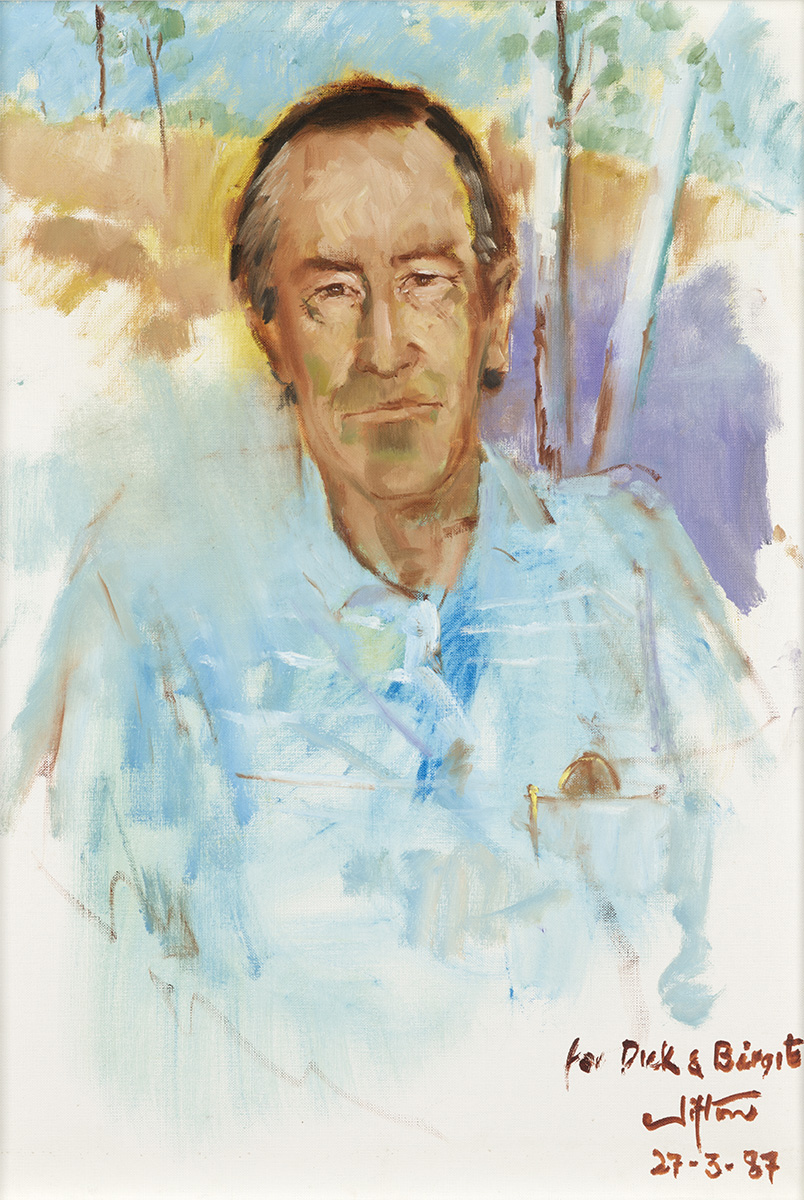 © the artist's estate and Trinity College, the University of Melbourne
© the artist's estate and Trinity College, the University of Melbourne
Richard Woolcott AC (TC 1946)
1987 Clifton Pugh AO 1924 - 1990 oil on linen 87.0 x 64.0 cm [framed] AC 000574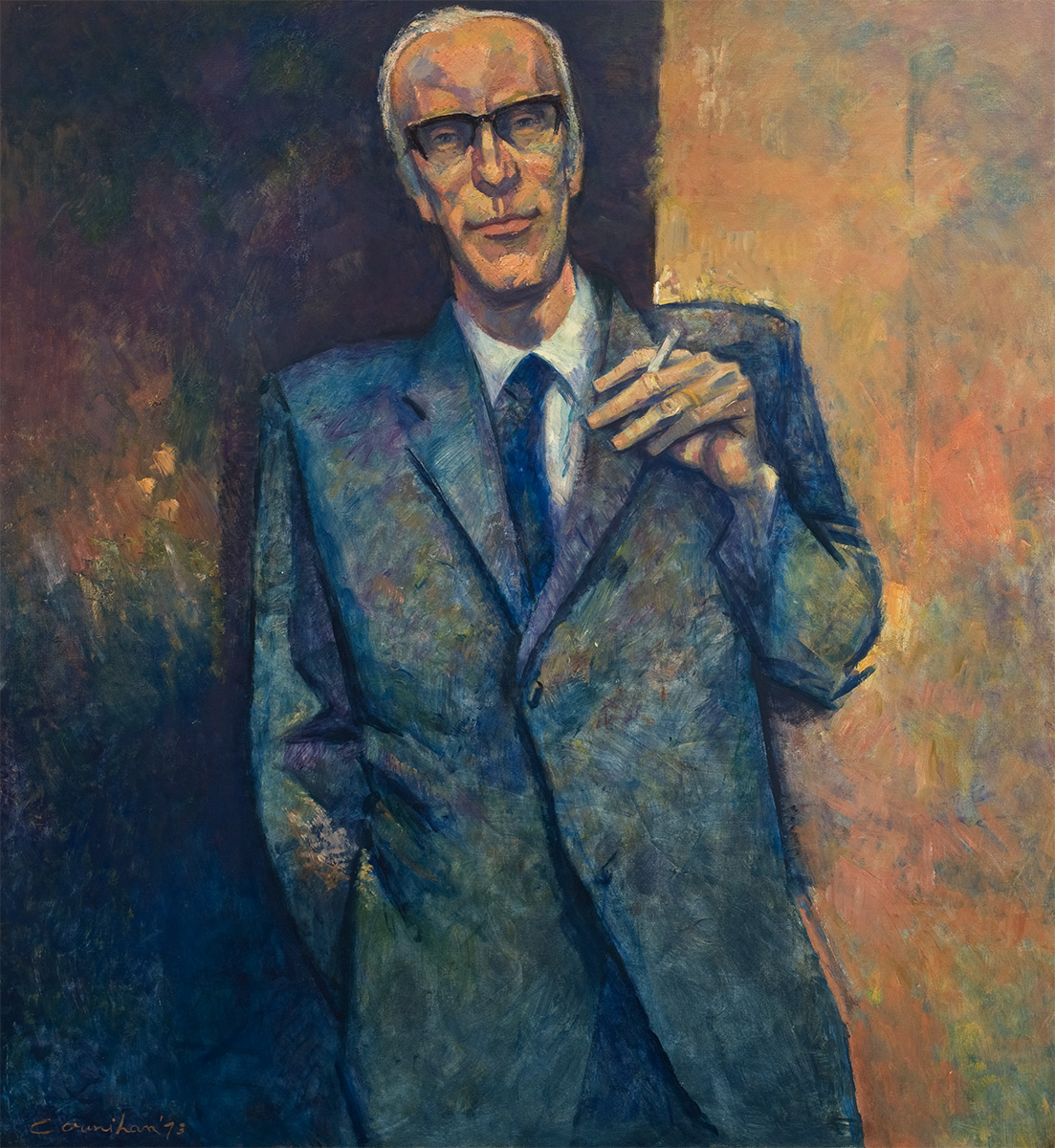 © Reproduced with permission of the estate of Mrs P. Counihan
© Reproduced with permission of the estate of Mrs P. Counihan
Sir Joseph Burke
1973 Noel Counihan 1913 - 1986 oil on composition board 136.1 x 127.4 cm [framed] On loan from the University Art Collection, 1975.0017.000.000before completing his Masters degree at Yale in 1936. He worked at the South Kensington Museum in London until the outbreak of war saw him seconded into the Public Service, rising to become private secretary to British Prime Minister Clement Attlee.
In 1947, Burke arrived in Australia to take up the role as inaugural Herald Chair of Fine Arts at The University
of Melbourne, a position encouraged by Daryl Lindsay, director of the National Gallery of Victoria, and endowed
by Sir Keith Murdoch, president of the gallery’s trustees and Chair of the Herald & Weekly Times.
Under Burke, The University of Melbourne’s Department of Fine Arts was established, the first of its kind in Australia. A fine scholar and an engaging lecturer, Burke held the role for thirty-two years, until his retirement in 1979.
An active participant in Melbourne’s academic and cultural life, Burke was an equally engaged member of the Trinity College community, as a resident art tutor, a Fellow, and a dedicated parishioner of the College Chapel. Trinity’s Sixth Warden Dr Evan Burge would reflect that Burke ‘became a true Australian’ with a great depth of understanding of the Australian landscape and ‘its intimate relationship with Australian art ... Above all he was a truly good man’.
On loan from the University of Melbourne
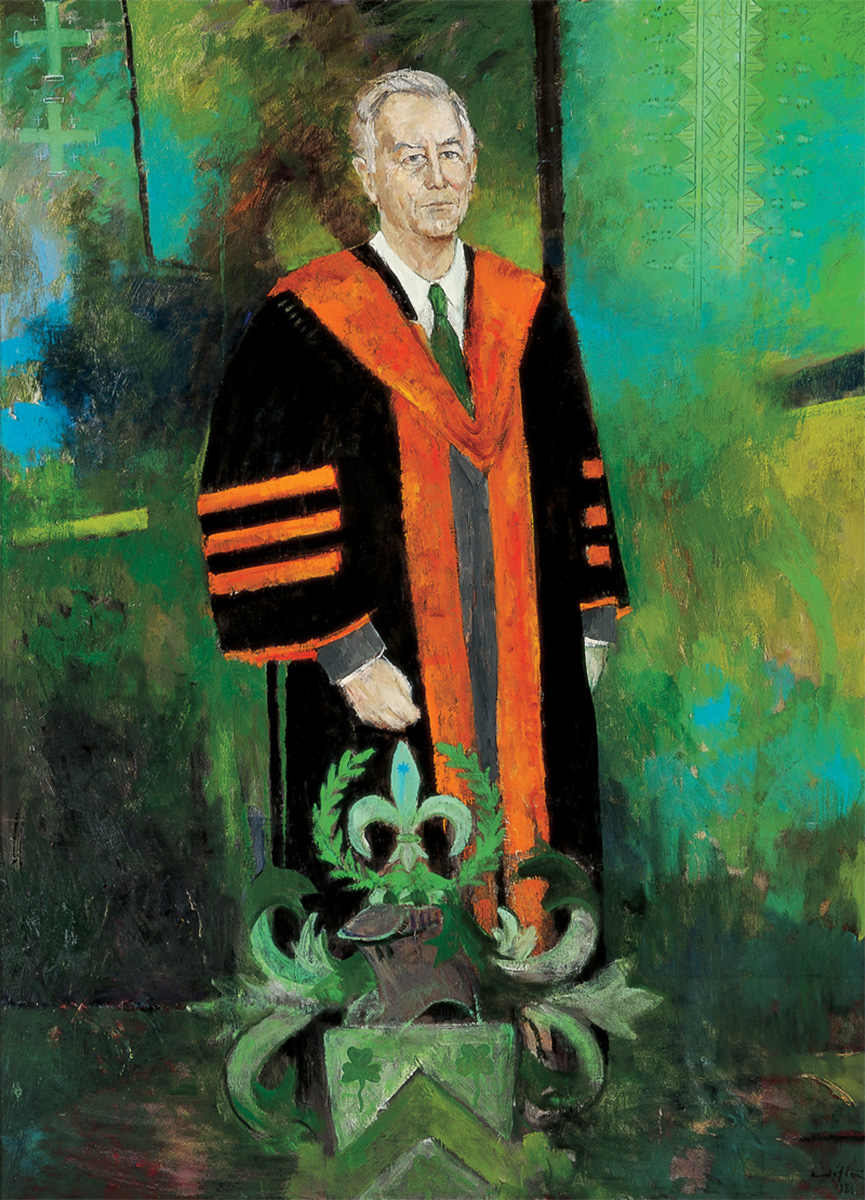 © the artist's estate and Trinity College, the University of Melbourne
© the artist's estate and Trinity College, the University of Melbourne
Revd Dr Evan Burge
1986 Clifton Pugh 1924 - 1990 oil on canvas 202.5 x 152.4 cm [framed] AC 000008It was Sir Andrew Grimwade's idea that a second portrait of Dr Burge be acquired for the College. In 1968 Sir Andrew had written the definitive account of Clifton Pugh's portraits, entitled Involvement: The Portraits of Clifton Pugh and Mark Strizic; thus he offered to commission Pugh to paint a portrait of Dr Burge. His generous gesture reflected his ambition that the College should emulate the custom of the Oxford colleges by acquiring portraits of its eminent members.
"Early in 1986", recalled Sir Andrew, "I drove Dr Burge to Pugh's home and studio at Dunmoochin, Cottles Bridge, and introduced him to Pugh. Whether the sitter was Prime Minister, Archbishop or another artist, Pugh's procedure was always the same. First he would make a quick sketch of the potential subject to see if he would consider the commission. Often, as in Dr Burge's case, the initial sketch would only take an hour or so. Conversation would then begin in a convivial atmosphere over lunch, and all the time Pugh would be assessing his subject in readiness for the next sitting.'
At the close of the first meeting, Pugh agreed to undertake the project on the condition that if either he or Sir Andrew were not happy with the result, the commission was at an end. Four sittings took place before the portrait was completed. When it was unveiled at the Fleur-de-Lys dinner in 1986, Clifton Pugh remarked to a large audience "Many of you will think of Evan as gentle but I have depicted a much tougher, less familiar side to him".
The likeness of Dr Burge as captured by Pugh is not the most controversial aspect of the portrait. Discussion about the work usually focuses on the vivid palette of flaming orange and leaf green. Pugh has provocatively brought together two colours residing at opposite ends of the spectrum. This was not an arbitrary decision. As a portraitist Pugh was always searching for the symbolic inference to signify the greater depths of his sitter's life and work. "I am trying to find something out about them. Something which I might consider the essence of them", he once commented. This he had achieved to great acclaim in his famous portrait of Archbishop Daniel Mannix. For his portrait of Dr Burge, he had asked that his sitter bring something of importance in his life to the first sitting.
Anxious to represent the College and the Church, Dr Burge brought with him the New Testament in Greek, the Trinity crest, a green stole and matching chasuble, and his academic gown representing the Princeton Doctorate. The Princeton robes are marked by three intense gills and facings of orange fabric. The chasuble is grass green in colour to symbolise the Trinity season and like the stole was made by Palestinian women whose craft was their only source of income. The crest is richly ornamented with filigree like foliage.'' Pugh consciously embraced the juxtaposition between colours not only because it was interesting to him but equally because the iconography was simply too powerful to ignore.
The stole in the upper left-hand corner carries a series of Jerusalem crosses and there is a richly embroidered panel on the chasuble, which is found in the opposite corner. Although there was no room for the Gospels in Greek, the assemblage does reveal a deep and thoughtful man. Surrounded by the chosen emblems of his sitter's life as scholar, priest and Warden, Pugh has captured a man of intellect, but one in whom, above all, a deep humanity prevails.
Presented with the support of Sir Andrew Grimwade CBE (TC 1949), 1986
Trinity College Art Collection
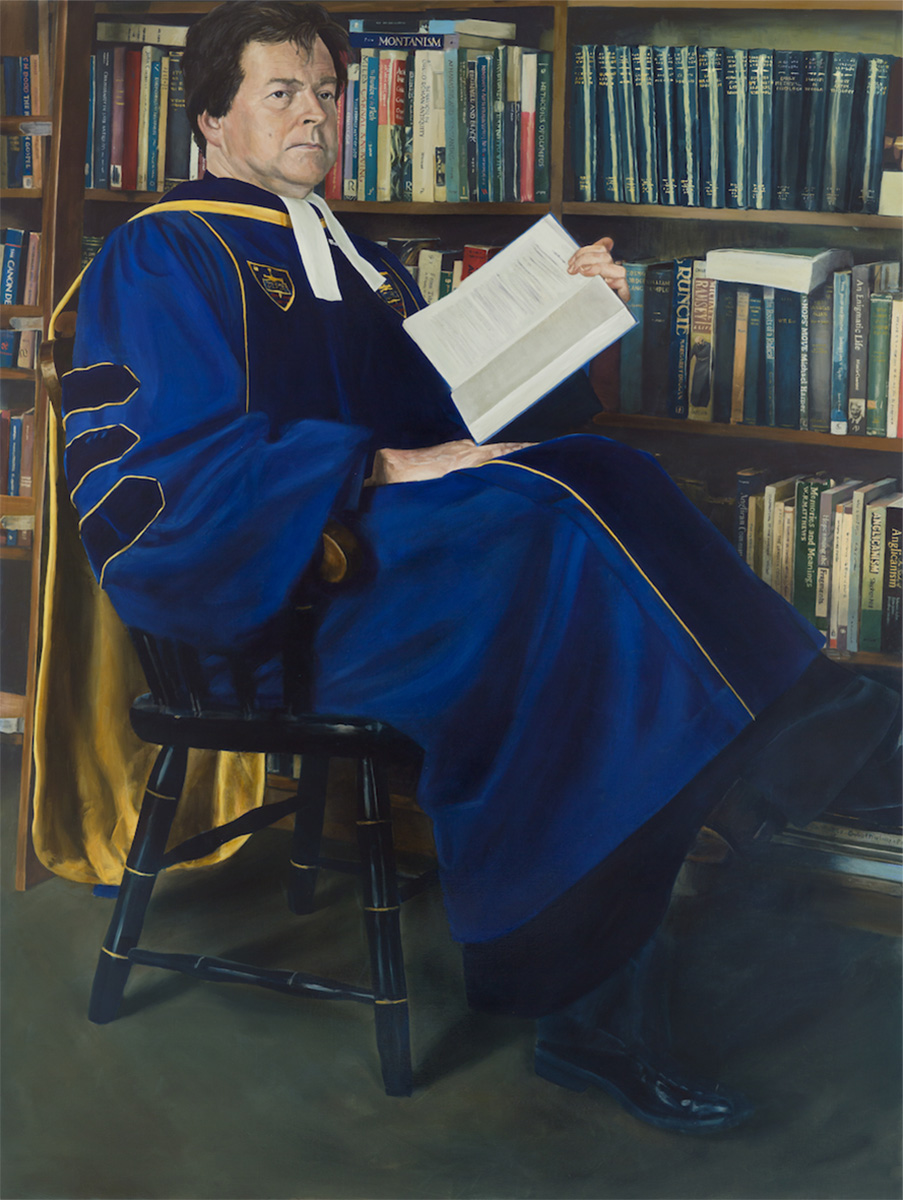 © the artist's estate and Trinity College, the University of Melbourne
© the artist's estate and Trinity College, the University of Melbourne
Revd Dr Andrew McGowan
2012 Charles Green, Lyndell Brown 1953 -1961 oil on linen 126.6 x 96.7 cm [framed] AC 000652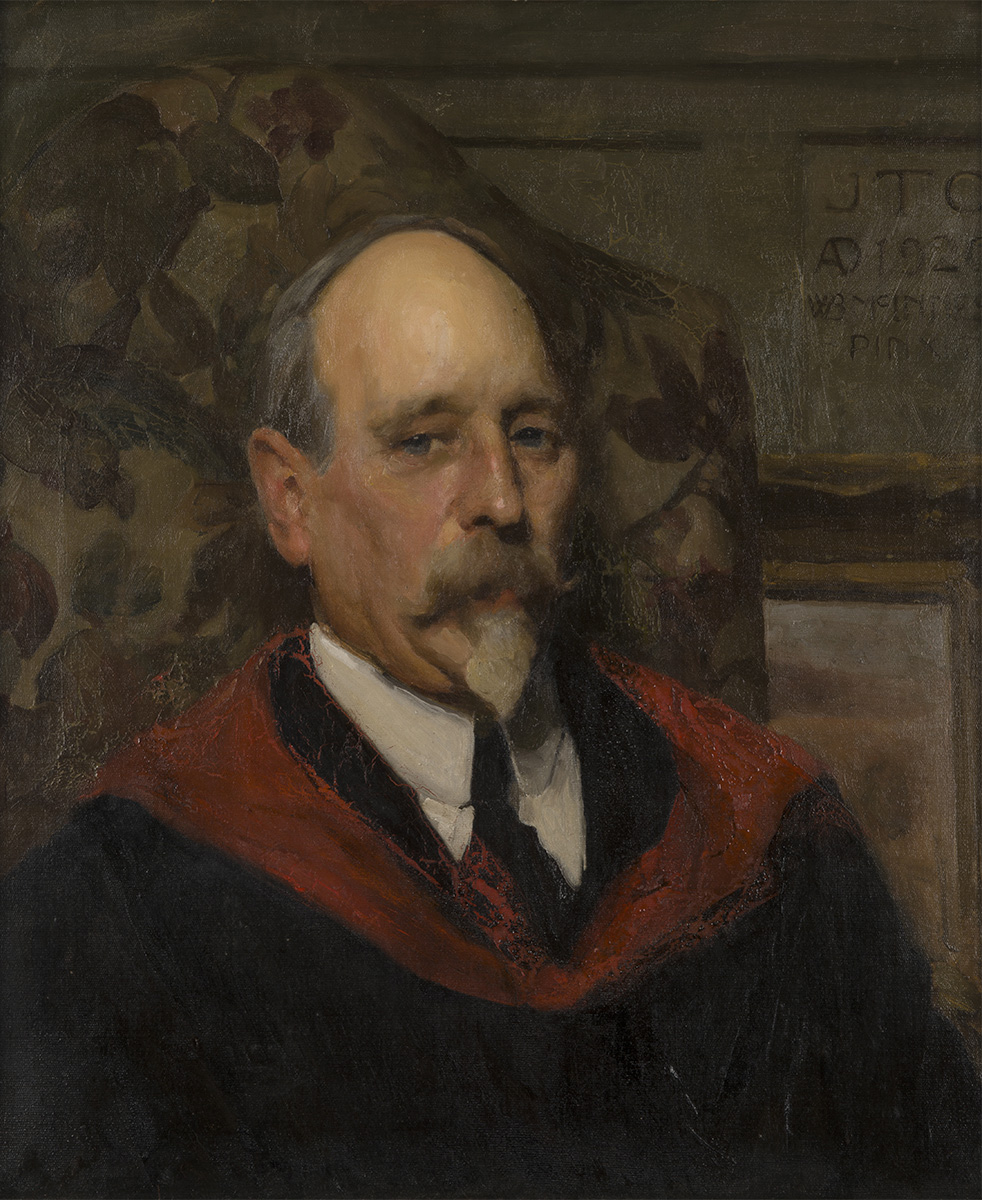 © Reproduction enquiries should be forwarded to Cultural Collections, Trinity College, the University of Melbourne
© Reproduction enquiries should be forwarded to Cultural Collections, Trinity College, the University of Melbourne
Joseph Thomas Collins
1920 William McInnes 1889 - 1939 oil on canvas 84.0 x 76.0 cm [framed] AC 000050At the time of painting his portrait of Joseph Thomas Collins, the Principal of the Trinity College Women's Hostel, W. B. Mclnnes had embarked upon "a distinguished and important career" as an artist.' Bertram Stevens declared in March, 1920, "The rise of W. B. Mclnnes to the very front rank of Australian painters in oil has become astonishingly rapid. The following year he won the inaugural Archibald Prize for Portraiture with his portrait of the architect, Desbrowe Annear, an achievement he repeated four years in succession. In total, Mclnnes won the Archibald seven times. His popularity was acknowledged in 1927 when he was commissioned to paint the opening of the Federal Parliament in Canberra.
In selecting a well-regarded artist such as Mclnnes, the College expressed the high esteem in which it held Collins. A Senior Tutor and non-resident Lecturer in Logic at Trinity, Collins was Leeper's man. He was appointed to take over the Women's Hostel in 1891 succeeding Miss Hensley whose departure underscored the famous 'schism' between keeper and Janet, Lady Clarke. Collins made a decisive and positive impact on the life of the Hostel.'
Within four years enrolment had almost doubled from nine to fifteen and a large number of this small student body achieved outstanding academic success at the University. Collins' nine years as Principal were a labour of love and commitment to women's education in Australia as he was never paid a salary. In 1901 Collins resigned as Principal to commence his career as a parliamentary draftsman.
Provenance: Commissioned by the College Council in 1920.
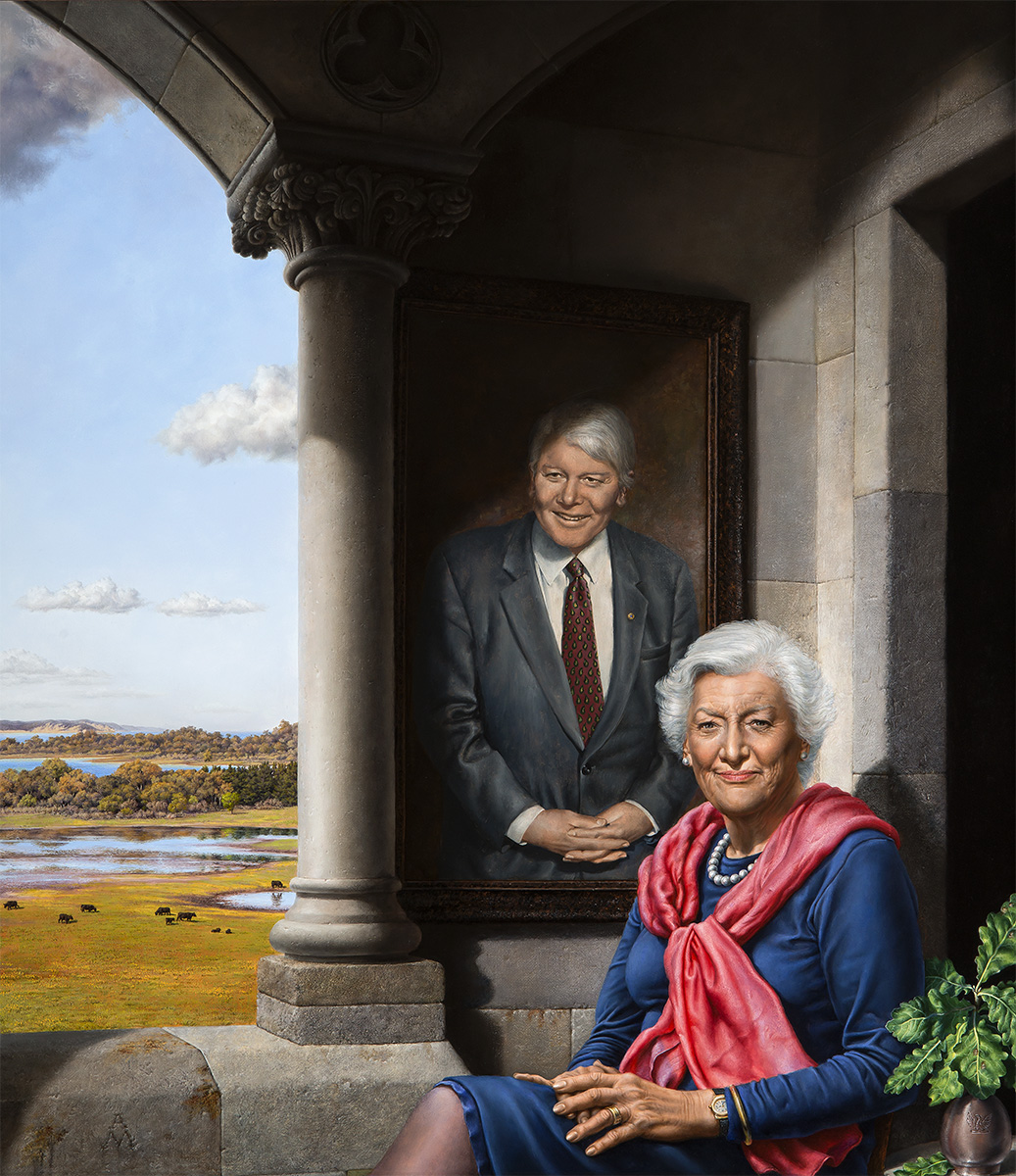 © the artist and Trinity College, the University of Melbourne
© the artist and Trinity College, the University of Melbourne
Louise and John Gourlay
2015 Andrew Mezei 1963 - oil on canvas 106.6 x 95.0 cm [framed] AC 000703‘united in a common goal - to secure the future of Trinity.’ It was illustrative of the Gourlay family’s largesse, both for the college and the wider community.
Unsettled by the excesses of the corporate sector, in 2004 the couple established a visiting professorship through a $2.5 million endowment to Trinity, in order to ‘promote the teaching of ethics in business to future leaders of the
corporate world.’
In 2008, Trinity’s opened its newest residental wing, named in recognition of the family’s support. That same year, she established the Louise Gourlay Prize of Social Change in the residential college. Like her 40 years of involvement with the Royal Children’s Hospital, she explains 'It’s not giving back, it’s just being part of helping if you can … I am going to keep going as long as I can.' This expession of service to the community was recongised in 2021 when she was elevated as a Member of the Order of Australia.
A landscape painter of extraordinary details, Andrew Mezei’s inaugural foray into portraiture was promptly
selected as a finalist in the 2011 Archibald Prize. This work is his second portrait, in which Louise sits with a portrait of the late John, framed by the college’s Clarke cloisters.
Commissioned by the Trinity College Art Committee, 2013
Trinity College Art Collection
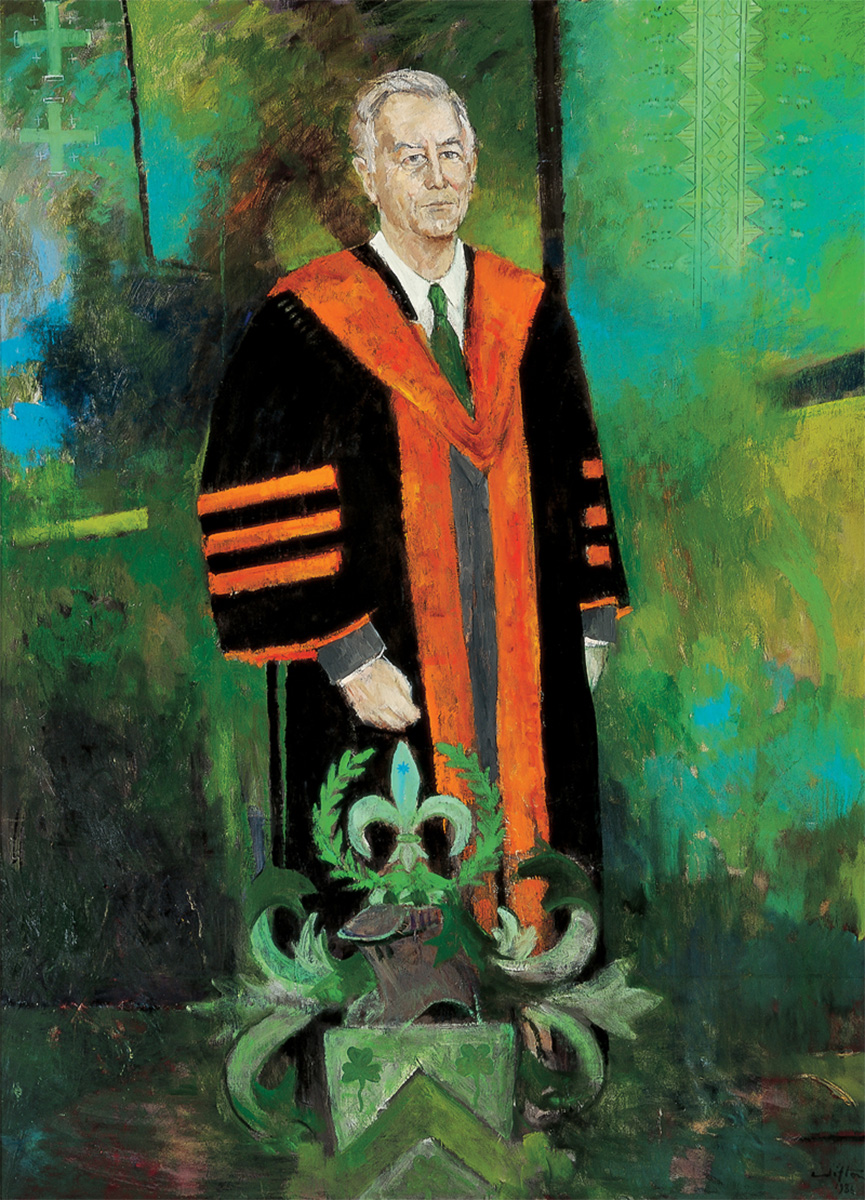 © the artist's estate and Trinity College, the University of Melbourne
© the artist's estate and Trinity College, the University of Melbourne
Revd Dr Evan Burge
1986 Clifton Pugh 1924 - 1990 oil on canvas 202.5 x 152.4 cm [framed] AC 000008It was Sir Andrew Grimwade's idea that a second portrait of Dr Burge be acquired for the College. In 1968 Sir Andrew had written the definitive account of Clifton Pugh's portraits, entitled Involvement: The Portraits of Clifton Pugh and Mark Strizic; thus he offered to commission Pugh to paint a portrait of Dr Burge. His generous gesture reflected his ambition that the College should emulate the custom of the Oxford colleges by acquiring portraits of its eminent members.
"Early in 1986", recalled Sir Andrew, "I drove Dr Burge to Pugh's home and studio at Dunmoochin, Cottles Bridge, and introduced him to Pugh. Whether the sitter was Prime Minister, Archbishop or another artist, Pugh's procedure was always the same. First he would make a quick sketch of the potential subject to see if he would consider the commission. Often, as in Dr Burge's case, the initial sketch would only take an hour or so. Conversation would then begin in a convivial atmosphere over lunch, and all the time Pugh would be assessing his subject in readiness for the next sitting.'
At the close of the first meeting, Pugh agreed to undertake the project on the condition that if either he or Sir Andrew were not happy with the result, the commission was at an end. Four sittings took place before the portrait was completed. When it was unveiled at the Fleur-de-Lys dinner in 1986, Clifton Pugh remarked to a large audience "Many of you will think of Evan as gentle but I have depicted a much tougher, less familiar side to him".
The likeness of Dr Burge as captured by Pugh is not the most controversial aspect of the portrait. Discussion about the work usually focuses on the vivid palette of flaming orange and leaf green. Pugh has provocatively brought together two colours residing at opposite ends of the spectrum. This was not an arbitrary decision. As a portraitist Pugh was always searching for the symbolic inference to signify the greater depths of his sitter's life and work. "I am trying to find something out about them. Something which I might consider the essence of them", he once commented. This he had achieved to great acclaim in his famous portrait of Archbishop Daniel Mannix. For his portrait of Dr Burge, he had asked that his sitter bring something of importance in his life to the first sitting.
Anxious to represent the College and the Church, Dr Burge brought with him the New Testament in Greek, the Trinity crest, a green stole and matching chasuble, and his academic gown representing the Princeton Doctorate. The Princeton robes are marked by three intense gills and facings of orange fabric. The chasuble is grass green in colour to symbolise the Trinity season and like the stole was made by Palestinian women whose craft was their only source of income. The crest is richly ornamented with filigree like foliage.'' Pugh consciously embraced the juxtaposition between colours not only because it was interesting to him but equally because the iconography was simply too powerful to ignore.
The stole in the upper left-hand corner carries a series of Jerusalem crosses and there is a richly embroidered panel on the chasuble, which is found in the opposite corner. Although there was no room for the Gospels in Greek, the assemblage does reveal a deep and thoughtful man. Surrounded by the chosen emblems of his sitter's life as scholar, priest and Warden, Pugh has captured a man of intellect, but one in whom, above all, a deep humanity prevails.
Provenance: Presented with the support of Sir Andrew Grimwade CBE (TC 1949) in 1986.
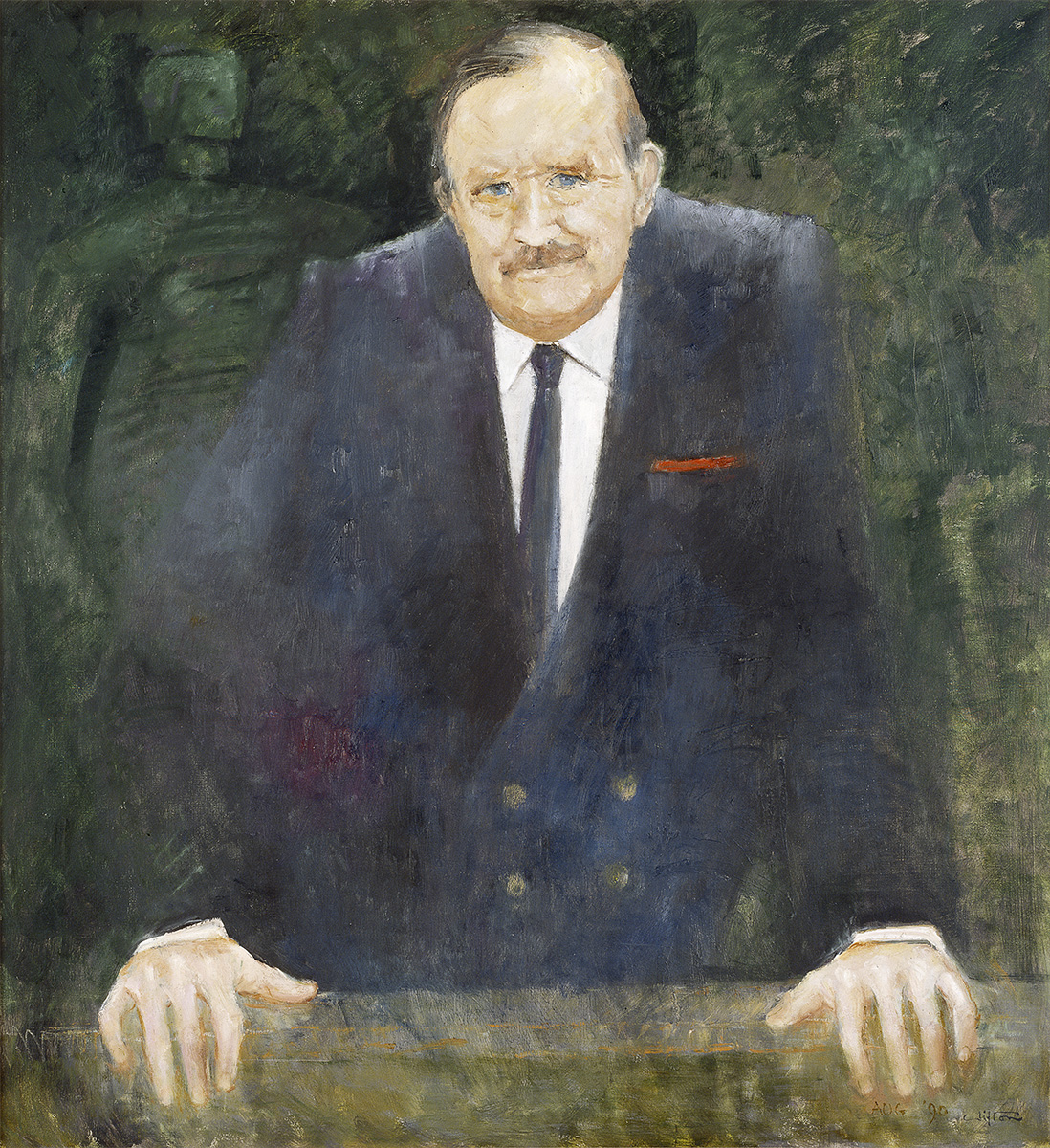 © Reproduced with permission of the estate of Clifton Pugh and the NGV.
© Reproduced with permission of the estate of Clifton Pugh and the NGV.
Sir Andrew Grimwade CBE (TC 1949)
1986 Clifton Pugh 1924 - 1990 oil on canvas 111.4 x 101.4 cm [framed] On loan from the National Gallery of Victoria, Felton Bequest, 1990, acc no. A8-1990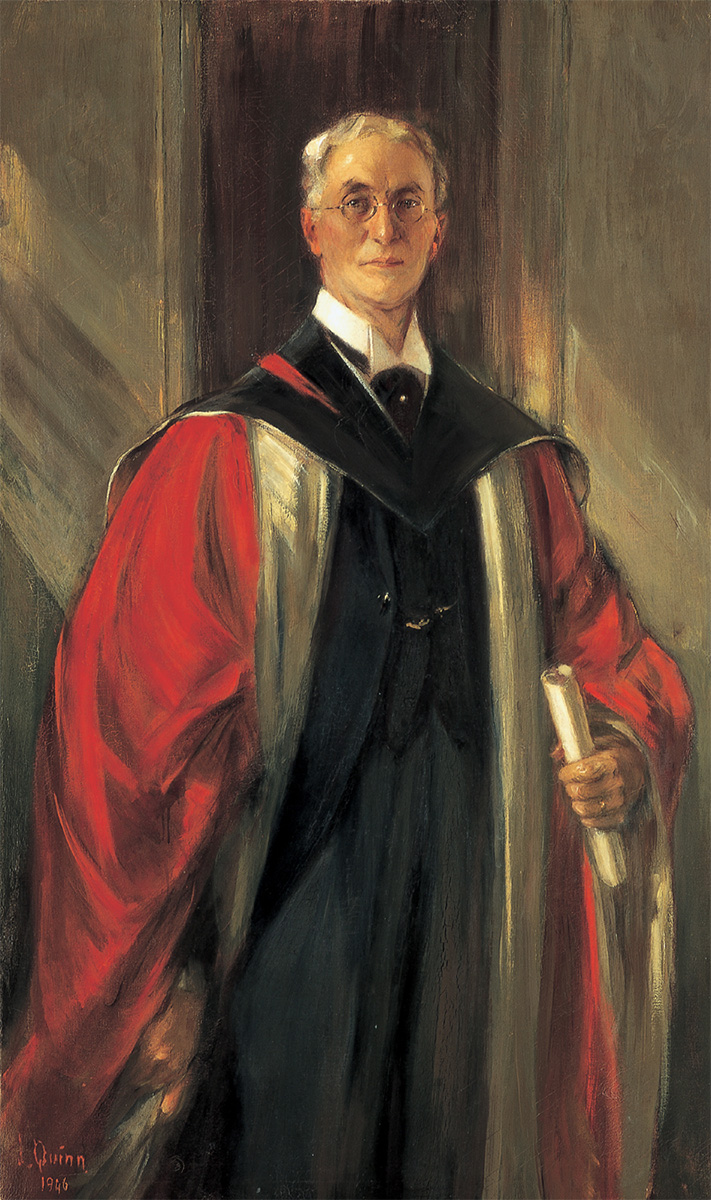 © the artist's estate and Trinity College, the University of Melbourne
© the artist's estate and Trinity College, the University of Melbourne
Sir John 'Jock' Clifford Valentine Behan
1946 James Quinn 1869 - 1951 oil on canvas 198.0 x 132.5 cm [framed] AC 000052In 1945 a group of students proposed that the College commission a portrait of Sir John Behan, the second Warden of the College. A sub-committee was formed to determine the artist and the cost of the portrait. The members, being unacquainted with the art world, turned to the vicechancellor, Mr J.D. Medley, who was "known to be knowledgeable about art", to assist them in making the decision. Medley recommended the Australian artist, James Quinn, who had gained an enviable reputation as a society portraitist in London before returning to Melbourne in 1937. Quinn agreed to the commission for a fee of £300.
If the College was expecting to rekindle the happy meeting of hearts and minds which had so characterised the Leeper-Bunny encounter, it was sadly mistaken. In the Trinity College Newsletter of July, 1982, F. J. Moreton, a former student of the College, and a prime mover of the enterprise, recalled that never were two men so at odds with each other as Quinn and Behan. Moreton had been selected to accompany Behan to Quinn's studio on the day the Warden was to sit for the artist. It soon became painfully obvious "that the two men, in a very short time, had developed either a fear or a dislike for each other". On reflection, Moreton adds, "it was probably both.
John Clifford Valentine Behan was the second Warden of Trinity College, assuming the wardenship on 23 April, 1918. Behan was an exceptional scholar. He had graduated in Arts with First Class Honours and Final Scholarships in the Schools of Logic and Philosophy and of History and Political Economy in Melbourne in 1904. In addition, he had taken First Class Honours in Law and the Final Scholarship in Law and was awarded numerous University and College Exhibitions and Prizes, including the Wyselaskie Scholarship and the Cobden Club Medal. He was a Trinity man and the College had been proud to claim him as such, especially so when he was elected Victoria's first Rhodes Scholar in 1904.
Behan's intellectual stamina was legendary. In Oxford in 1906, he was awarded First Class honours in both Jurisprudence and in the Bachelor of Common Low, a near impossible feat given that the two examinations overlapped by one paper. Behan left the last paper in Jurisprudence after 90 minutes and wrote the first paper of B.C.L. in the remaining 90 minutes. He was the only student in the history of the Oxford Law School to have achieved such an extraordinary act.''
As Warden, Behan demanded the same exacting standards of his students as he did of himself. He was not a man to suffer fools gladly and his reputation was that of an aloof and austere man, very much in the manner in which Quinn has portrayed him in this portrait. He inherited a College whose urgent need to expand was seriously inhibited by a perilous financial position. He approached this challenge with alarming zeal. In 1935 his first goal was achieved when a handsome stone building facing Royal Parade was opened. In honour of his service to the College the building was named "Behan".
Moreton's reflections support this impression of Quinn. He wrote:
'...with hindsight, it could be said that, had the sub committee been more sensitive and less enthusiastic, it would have been apparent to them that the development of a satisfactory relationship between Jock and Quinn the artist would be highly improbable. Quinn's appearance and manner were then somewhat less than personable and his studio in more chaos than one could reasonably expect from an artist.'
In the Trinily portrait, a sense of disdain is clearly apparent in the Warden's expression and it is tempting to conclude that Quinn's manner may have prompted Behan's expression of hauteur.
Provenance: Commissioned by the College Council in 1945
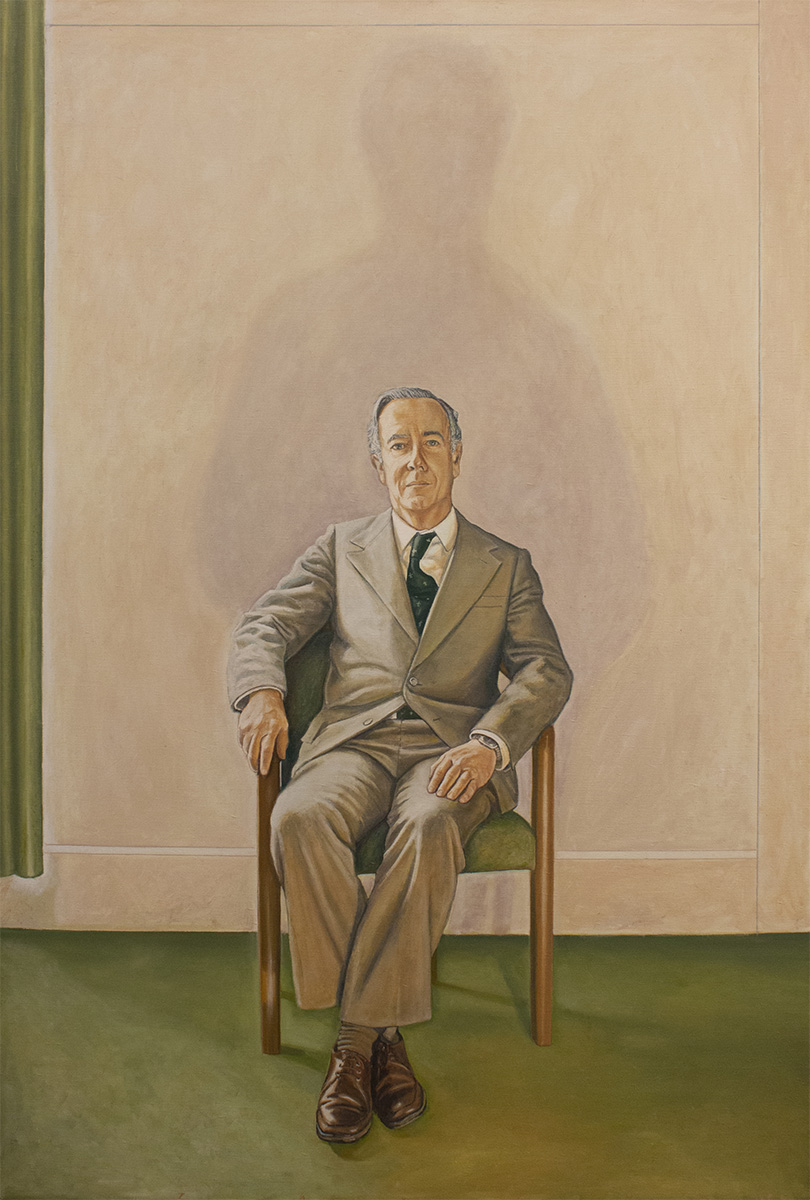 © the artist's estate and Trinity College, the University of Melbourne
© the artist's estate and Trinity College, the University of Melbourne
Revd Dr Evan Burge
1984 David Thomas 1951 - oil on canvas 152.0 x 102.0 cm [framed] AC 000003The portrait was commissioned by Mr Robert Cripps as a tribute to Dr Burge's leadership as Warden, and for his efforts in persuading a cautious Council to accept the generosity of the donor who, on behalf of his family, had offered to restore the fabric of the Horsfall Chapel. In true philanthropic spirit, Cripps also saw it as an opportunity to support an up-andcoming artist whose work he admired.
The portrait is the earlier of two portraits of Dr Burge, fifth Warden of Trinity College. The later portrait is by Clifton Pugh. Dr Burge recalls that sitting for David Thomas was a very different experience from being painted by Pugh. Thomas adopted a highly ordered approach, taking photographs and making sketches at each sitting but never painting in the presence of the sitter. His work testifies to an interest in realist detail. At the time, Thomas was to some degree influenced by Brian Dunlop. He seemed to take a particular interest in Dr Burge's brown shoes, which the Warden remembered wearing frequently during that period. They are given an unusual prominence in this portrait.
One of the most notable features of the portrait is the large shadow cast behind the sitter. Thomas experimented with various lamps during the process and was intrigued by the shadows they cast and the symbolism they suggested. The large shadow in this portrait, which is not at ail realistic, suggests an enhanced presence. It is not the presence so much of the individual, but more an allusion to the authority of Burge's role as Warden.
In appointing Dr Evan Burge as its fifth Warden, the College was once again presided over by a Classics scholar. He came to Trinity College at the begining of June, 1974. Previously he had been lecturer and then senior lecturer in Classics at the Australian National University. His first degree in Classics was from the University of Queensland, from which he graduated with First Class Honours and a University Medal in 1956, and was awarded a Queensland Government Travelling Scholarship to Balliol College, Oxford. Two years later, he graduated with First Class Honours in Literae Humaniores ("Greats"). While in Oxford, he married a Queensland medical graduate. Dr Barbara Payne. By the time they came to the Warden's Lodge in Trinity, they had six children, three boys and three girls. His success at Oxford led to his appointment to the Canberra University College, later the School of General Studies at the Australian National University. While a lecturer in Canberra, he studied, during two periods of leave, under Professor Gregory Vlastos in the Classical Philosophy Programme at Princeton University, New Jersey, and was awarded his Ph.D. in 1969 for a thesis on Plato and Causality.
In Canberra, Dr Burge was ordained as honorary deacon of the Anglican Church by Bishop Ernest Burgmann in 1960 and as Priest in 1 971. He became deeply involved in writing liturgies during this period and in 1 970 was appointed a member of the national Anglican Liturgical Commission. He was responsible for drafting the widely used second order for the Holy Communion in An Australian Prayer Book (1978) and for the Collects in A Prayer Book for Australia (1995). At the same time he always retained his admiration and affection for The Book of Common Prayer.
As Warden of Trinity, Dr Burge saw many changes, especially the introduction of women to co-residence in 1974, following decisions in principle taken in Professor Sharwood's last year. The incorporation of the College by Act of Parliament in 1979, the establishment of the Trinity College Foundation in 1983, and of the Trinity Foundation Studies Program for overseas students in 1989, and the adoption of a major Strategy Plan in 1994 were other important changes. The cultural life of the College was a special concern of his, especially the establishment of the Trinity College Choir in 1975 and the gradual improvement in the standard of production of Trinity plays and musicals. Dr Burge also had oversight of the formation of the Art Committee and the E.R. White Club following the contentious sale of the John Brack painting, The Breakfast Table in 1989.
A new building, named the Evan Burge Building, was opened on 19 April, 1996, by Sir Ninian Stephen. Containing teaching rooms, a lecture theatre and a magnificent library area which houses the Leeper and Mollison libraries on the upper level, it stands as his permanent memorial within Trinity. This would not have been possible without the Trinity Foundation Studies Program and the Trinity College Foundation and the many people who worked tirelessly for them. He retired on 30 September, 1997, and was made a Fellow in November, 1997. The sixth Warden, Professor Donald Markwell, was installed on 15 September, 1997.
Commissioned by Mr Robert Cripps, 1984
Trinity College Art Collection
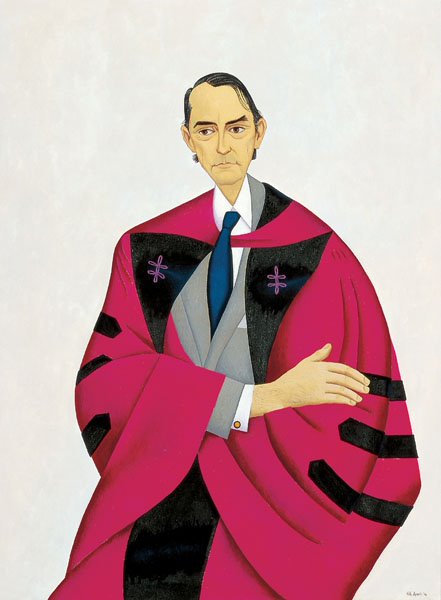
Prof Robin Sharwood
1974 Rick Amor 1948 - oil on canvas 143.3 x 109.7cm [framed] AC 000055Robin Sharwood assumed office as Trinity’s fourth Warden, in June 1965. He was just 33 years old, having completed his Doctor of Judicial Science at Harvard under a Fulbright Scholarship. Educated at The University of Melbourne, he graduated with First Class Honours in Law and in 1954 was awarded the Supreme Court Prize.
As Warden, he steered the transition of the college from a male-only residential college to co-residential one, a
change that would come into effect in 1974, after his retirement the previous year to take up the role as
the inaugural Executive Director of the Victorian Law Foundation. He was made a Fellow of Trinity in 1980, and
a Member in the Australia Day Honours in 2001.
A lay Canon of St Paul’s Cathedral for over thirty years (1967-2001), he also served as Chancellor of the Anglican
Dioceses of Wangaratta (1974-99) and Ballarat (1995-2002). Since 2018, the Sharwood Lecture in Church Law
has been held annually by Trinity College.
In commissioning a portrait of Sharwood, the College Council were directed to prominent art dealer, Dr Joseph
Brown, who astutely suggested a recent graduate of Melbourne’s National Gallery School. Rick Amor’s striking
and unconventional portrayal of the out-going Warden set a new benchmark among the college’s existing portraits
and remains a popular favourite at Trinity among students.
Following his departure, Professor Sharwood continued to give generously to the College, in particular building up its collection of modern Australian prints. Perhaps his most utilitarian legacy was the first inventory of the art collection, which was completed by Leonard Joel in 1972. He died in April 2015, at the age of 83.
Commissioned by the College Council, 1972
Trinity College Art Collection
